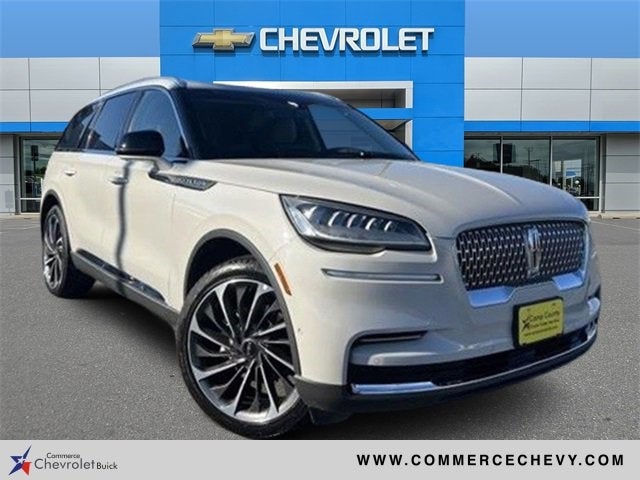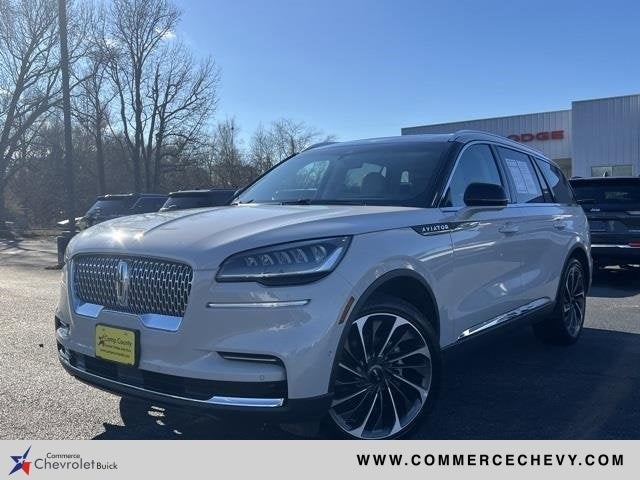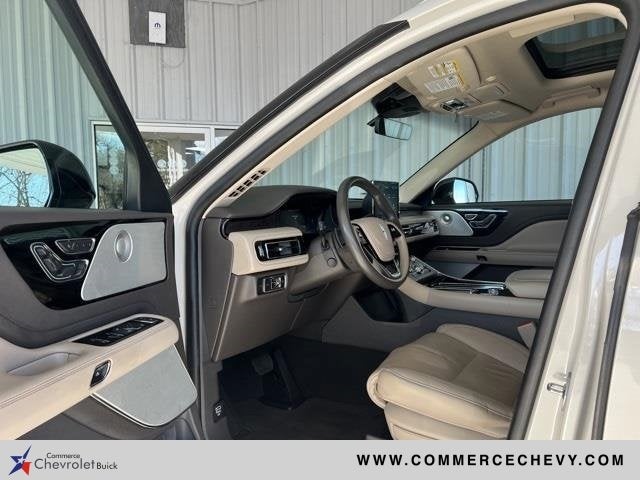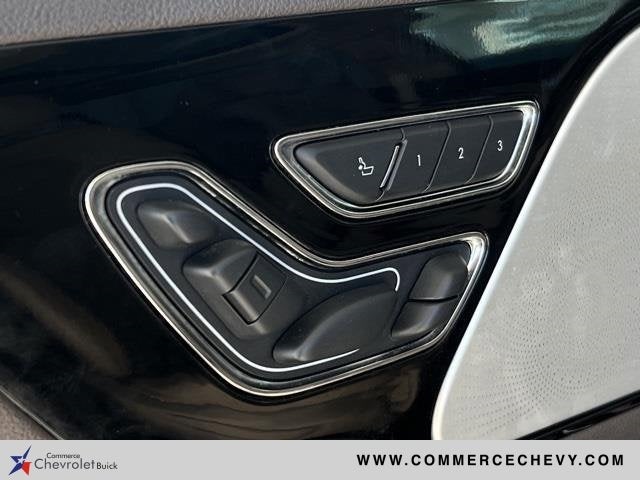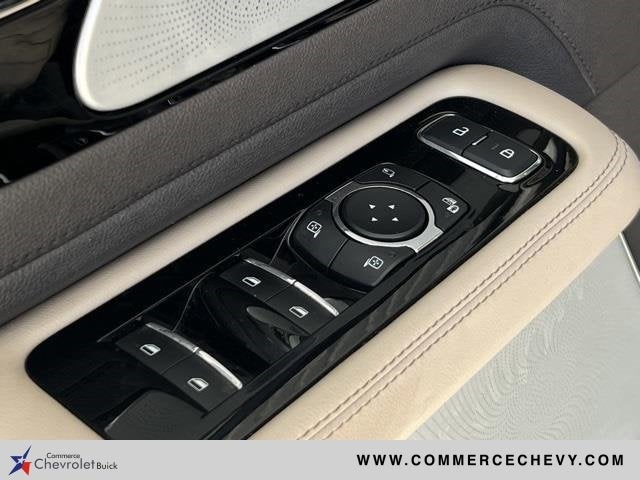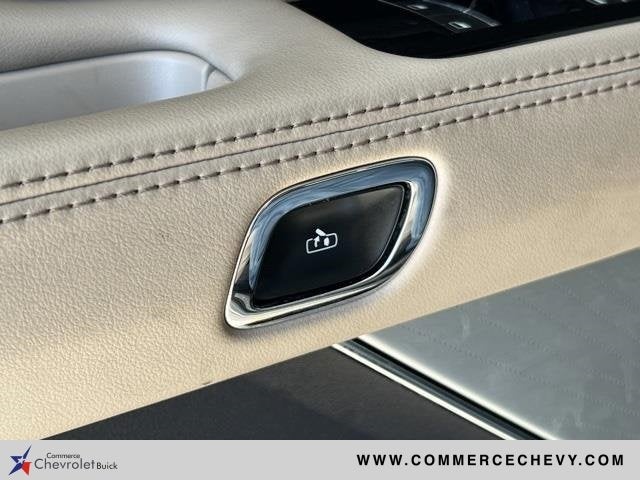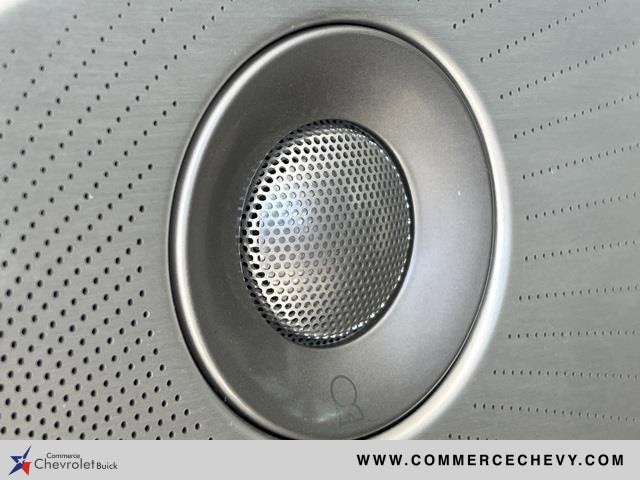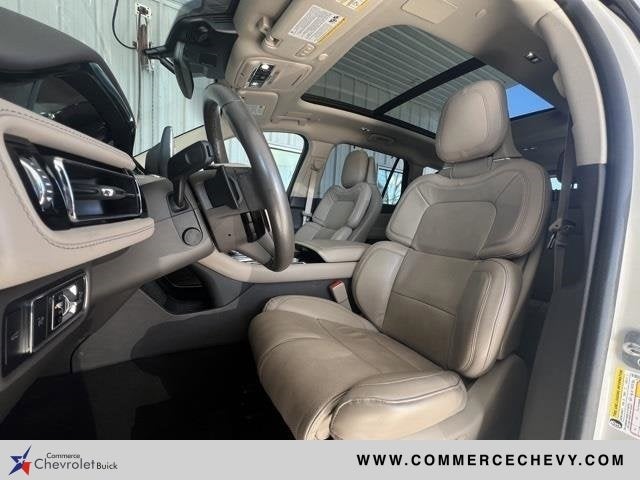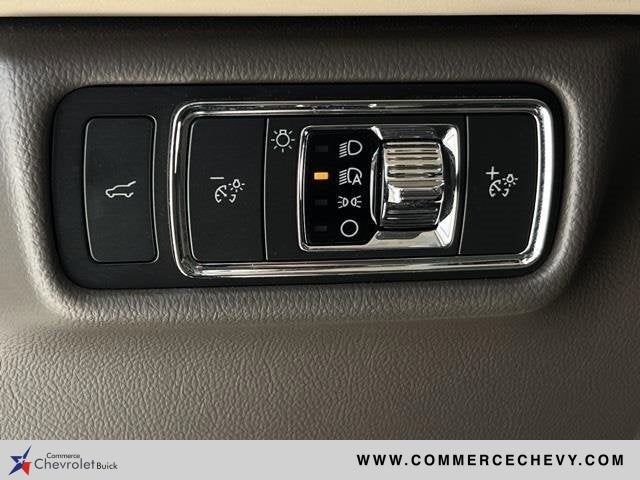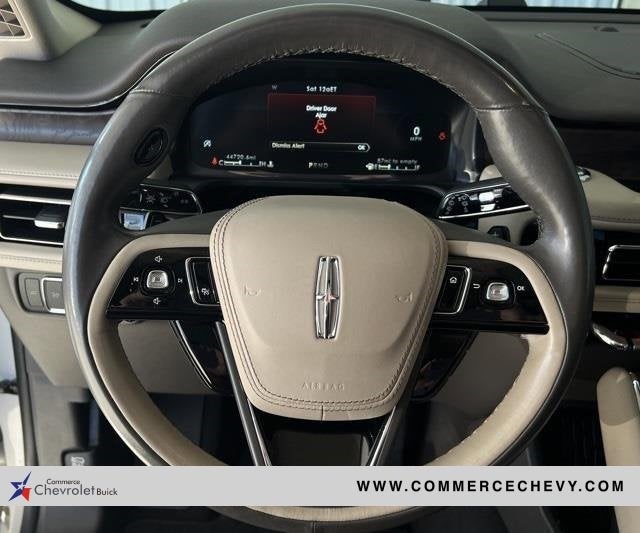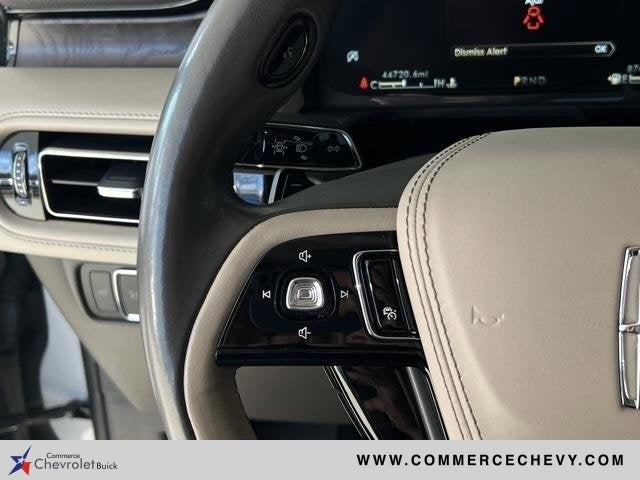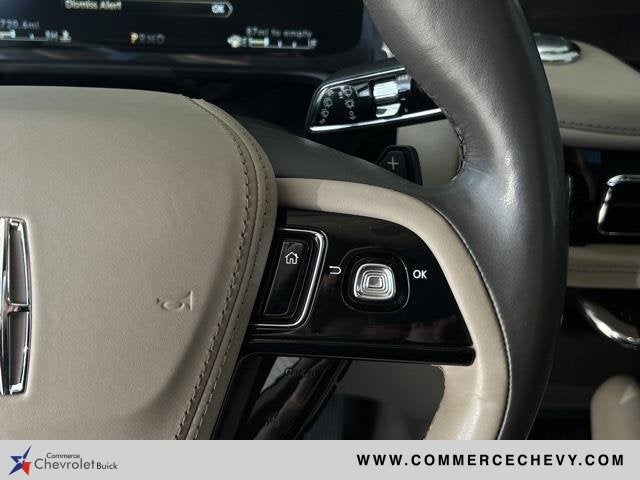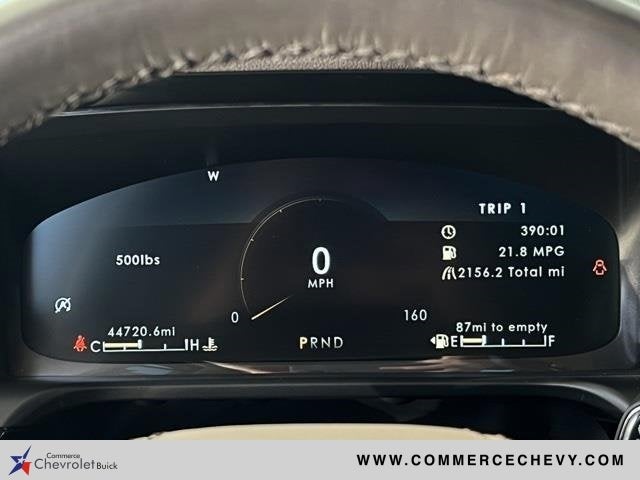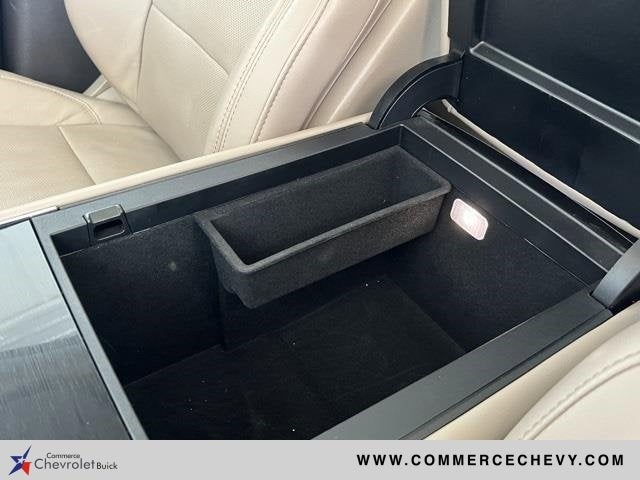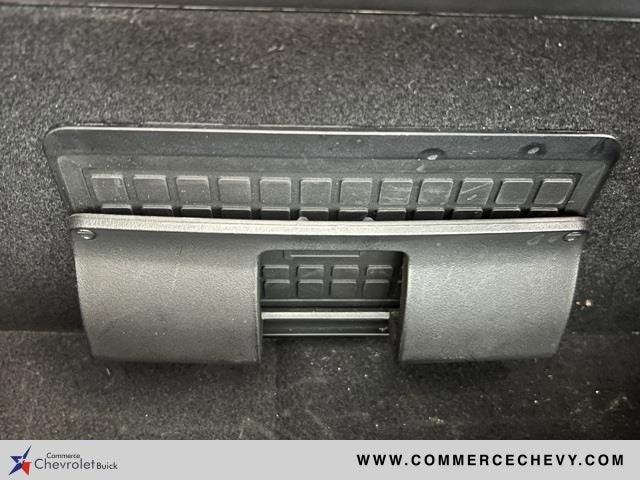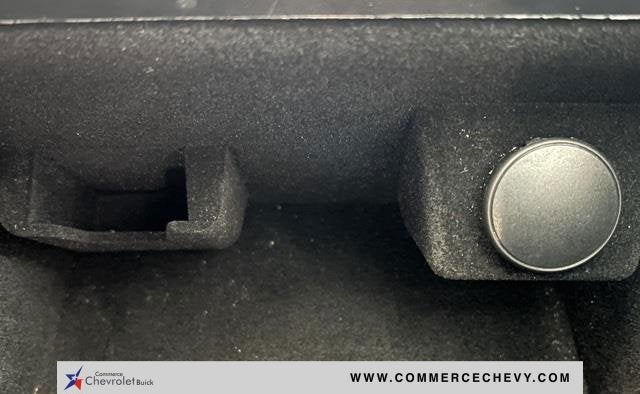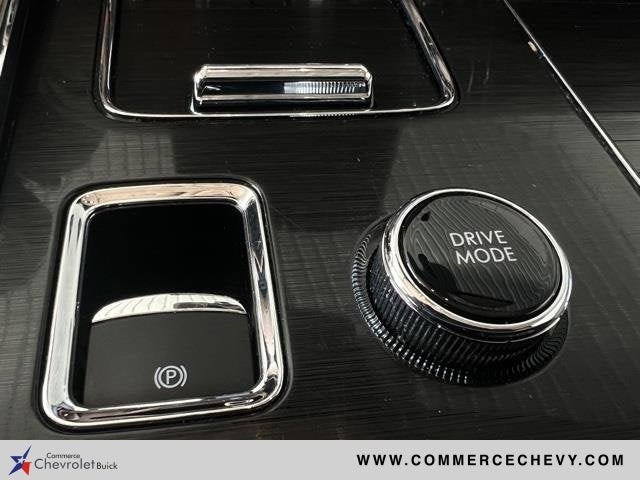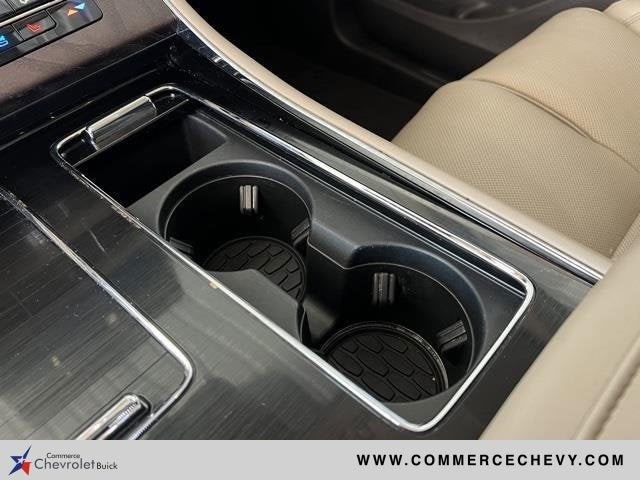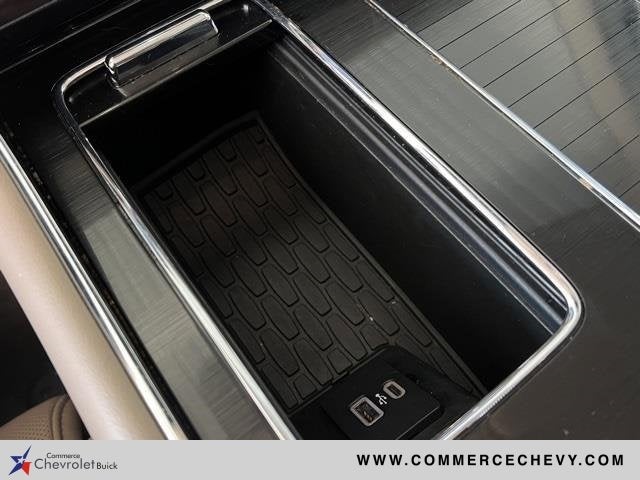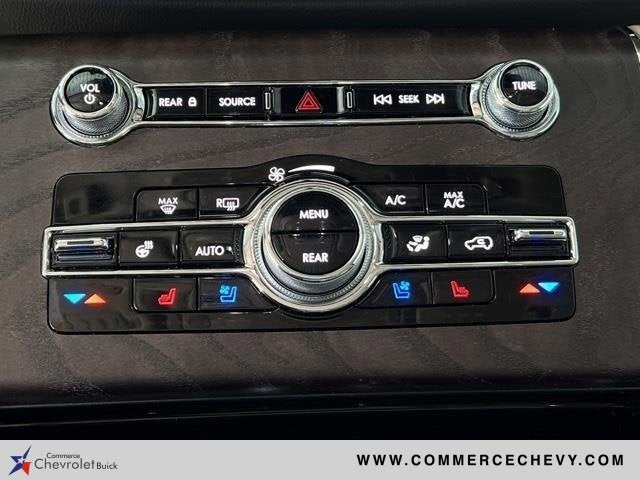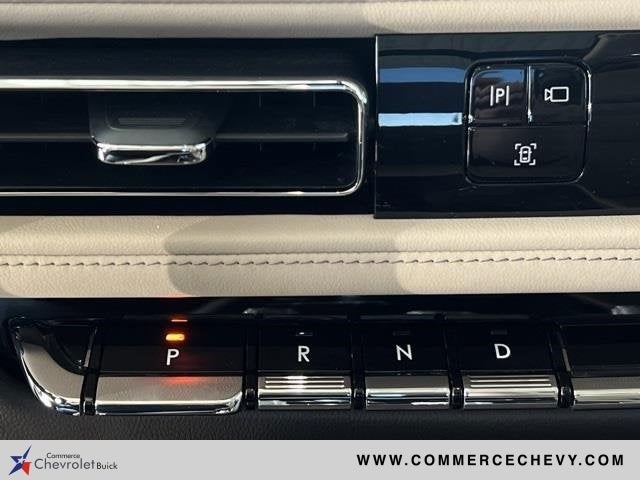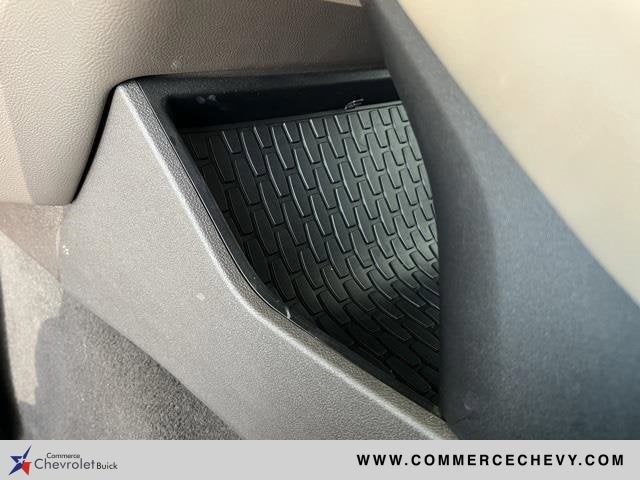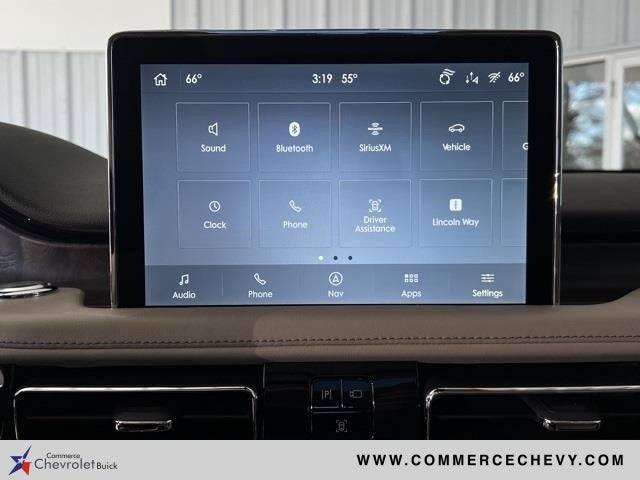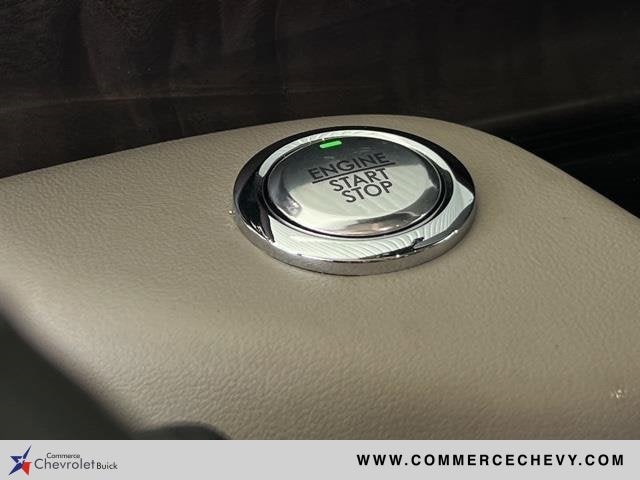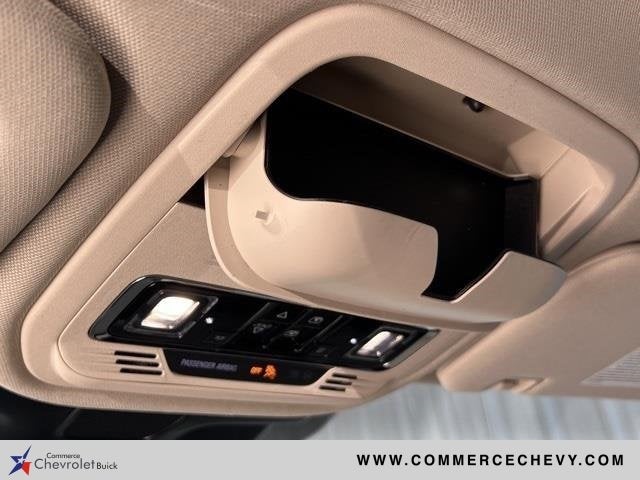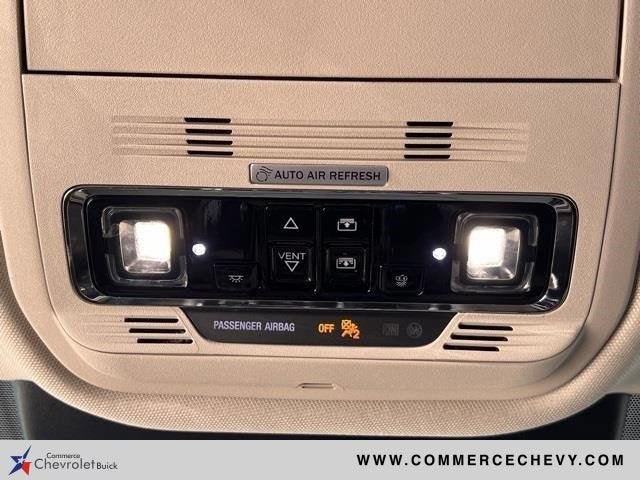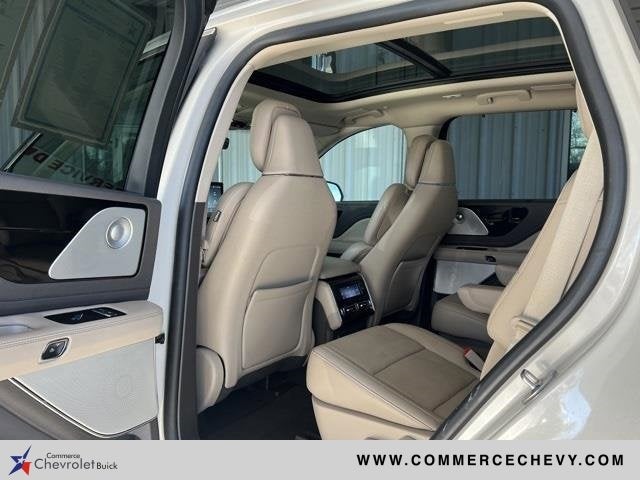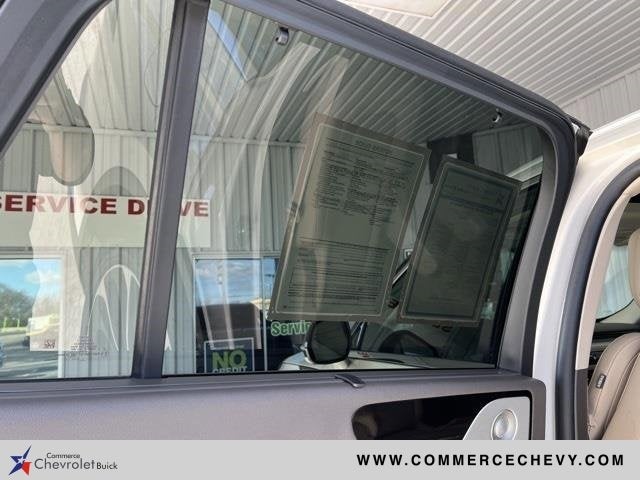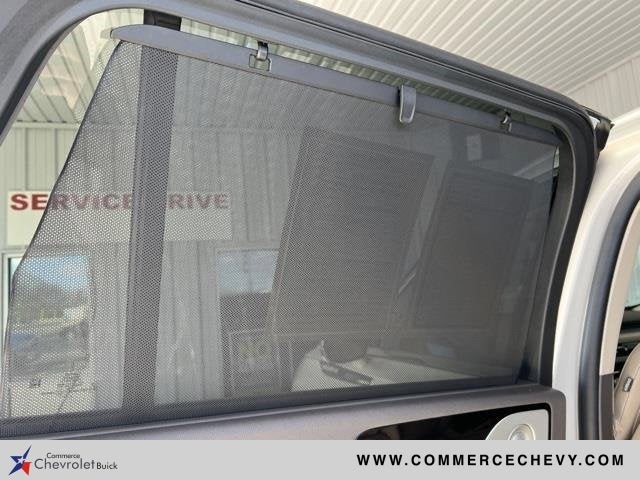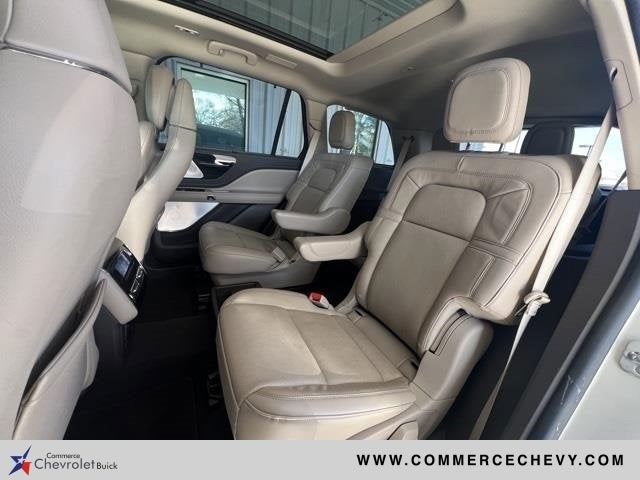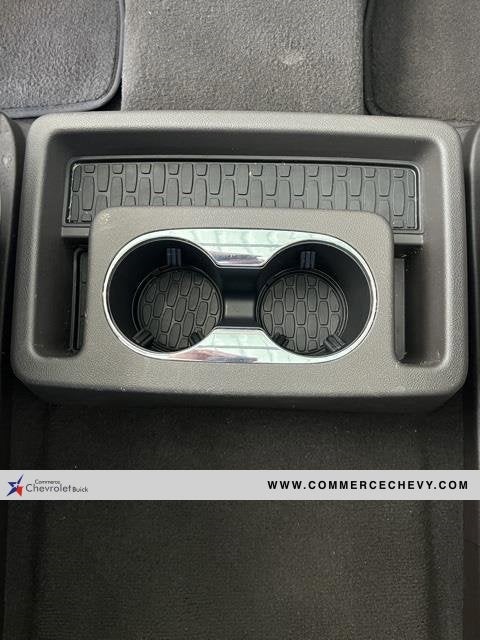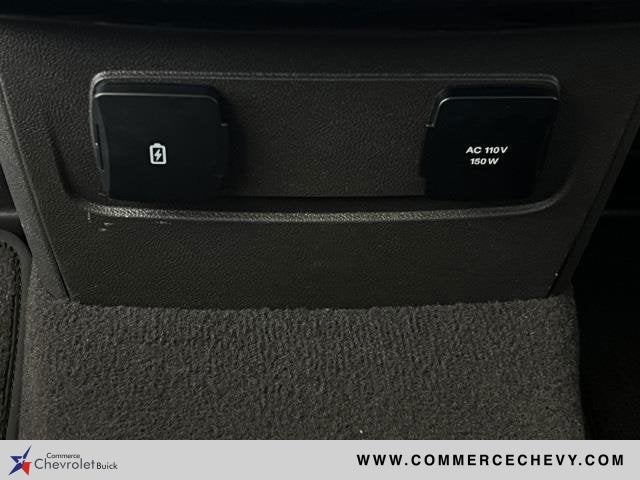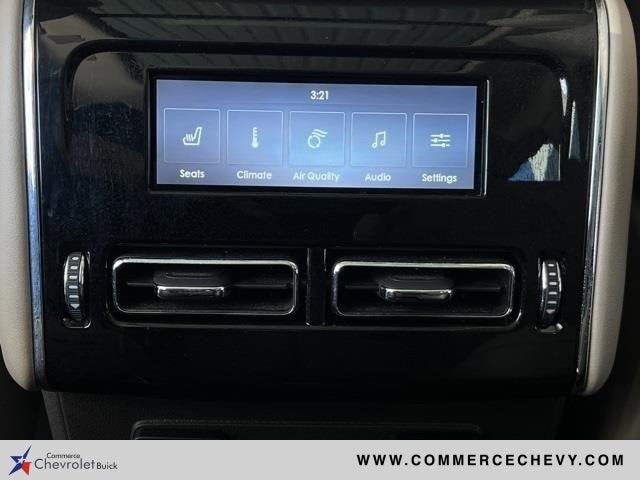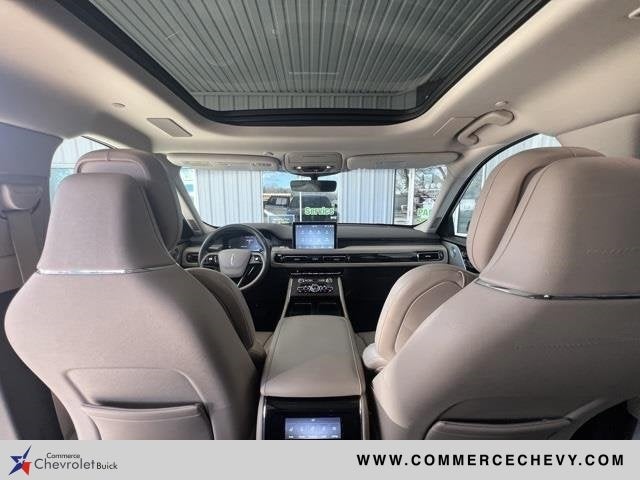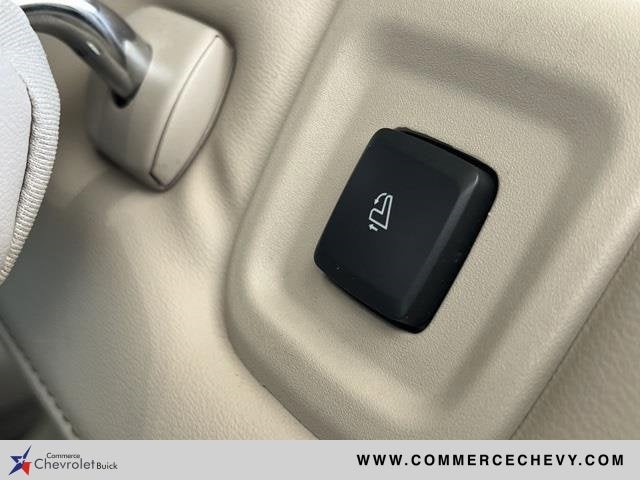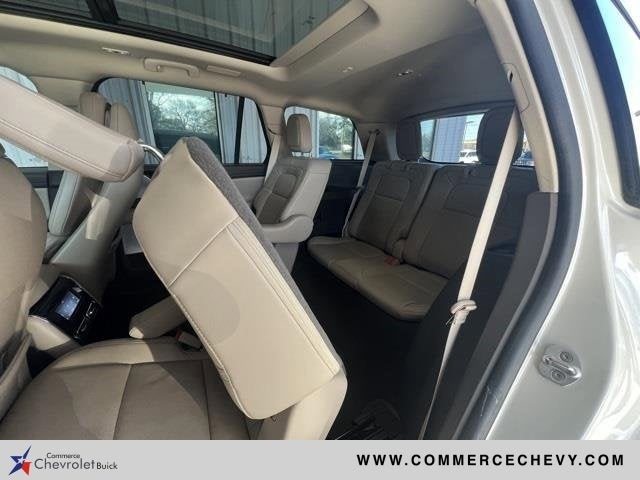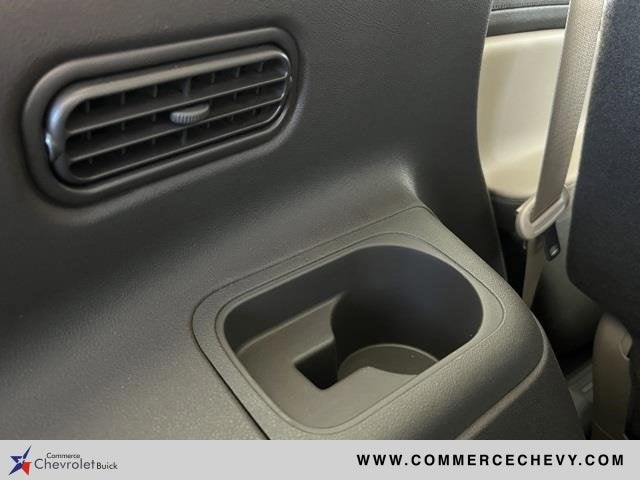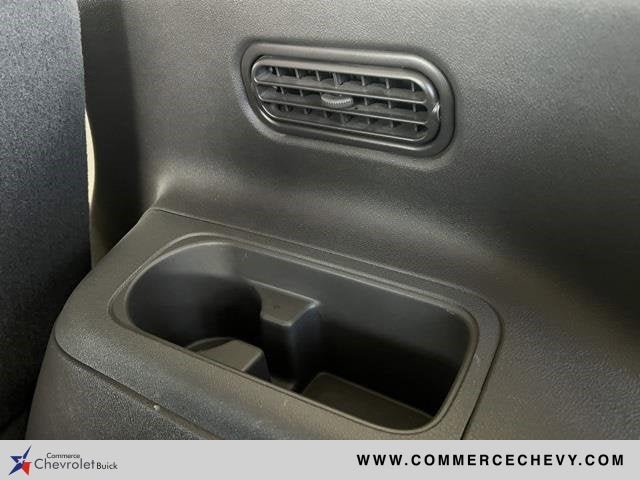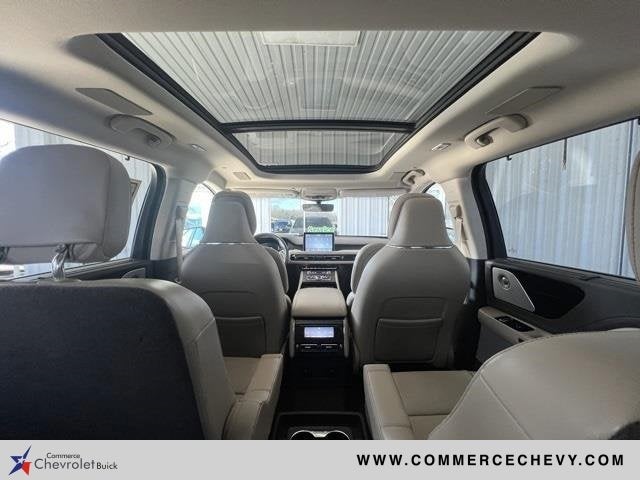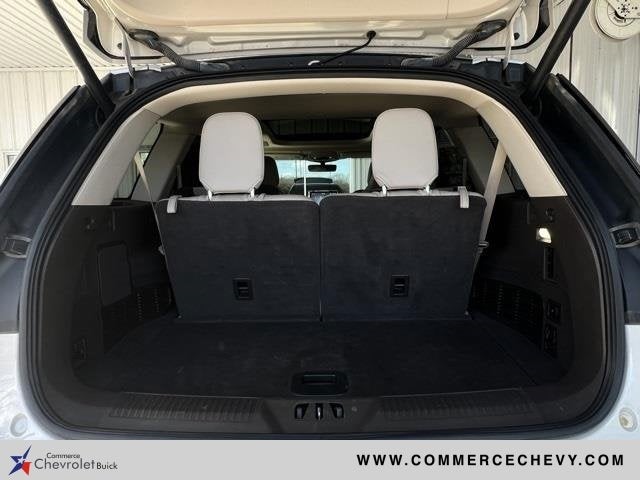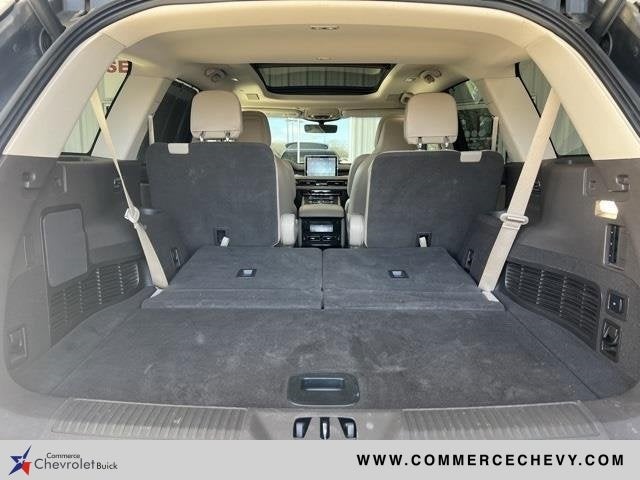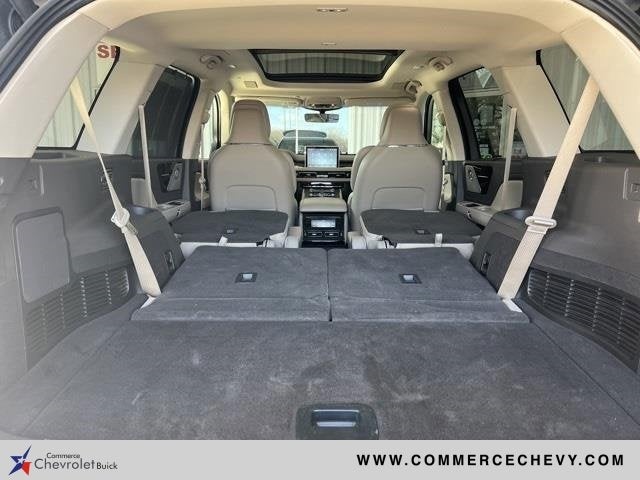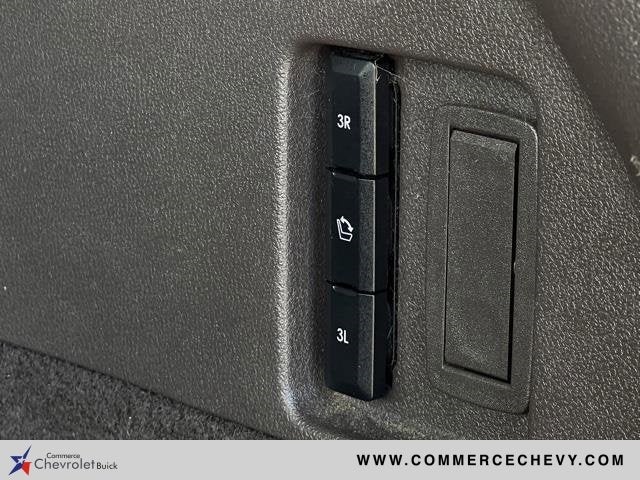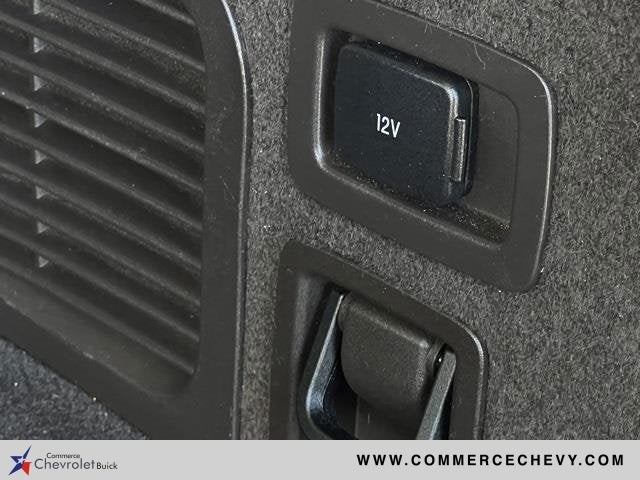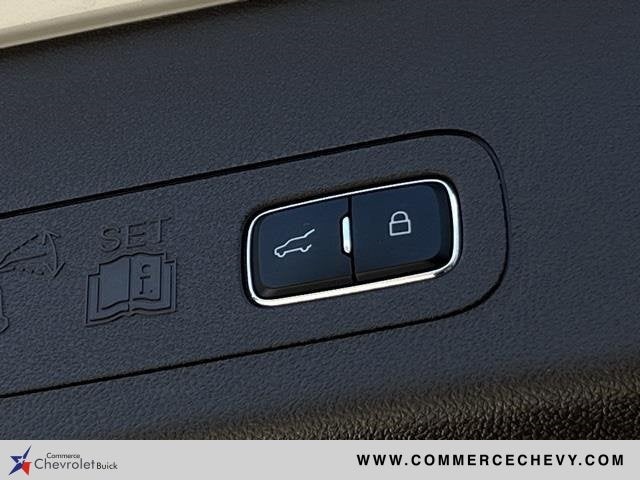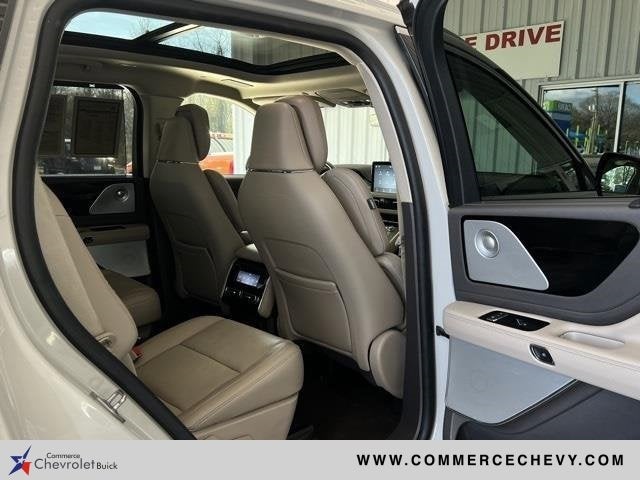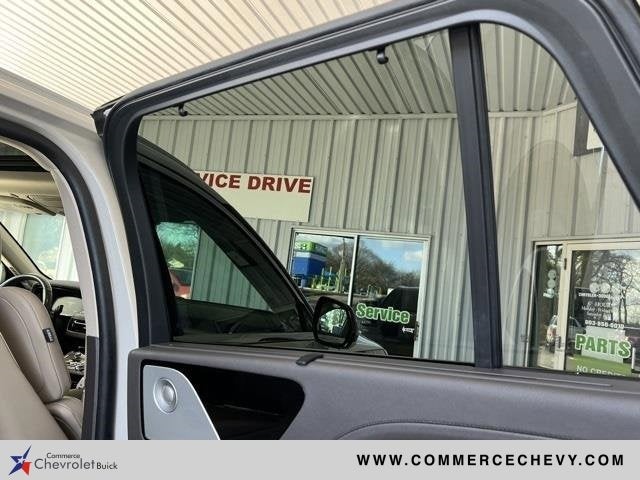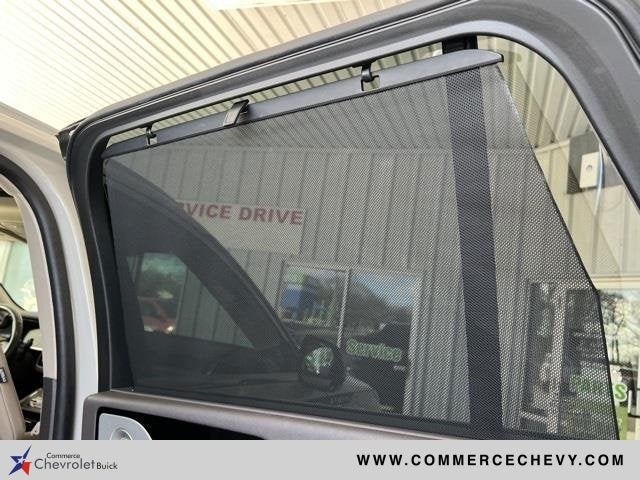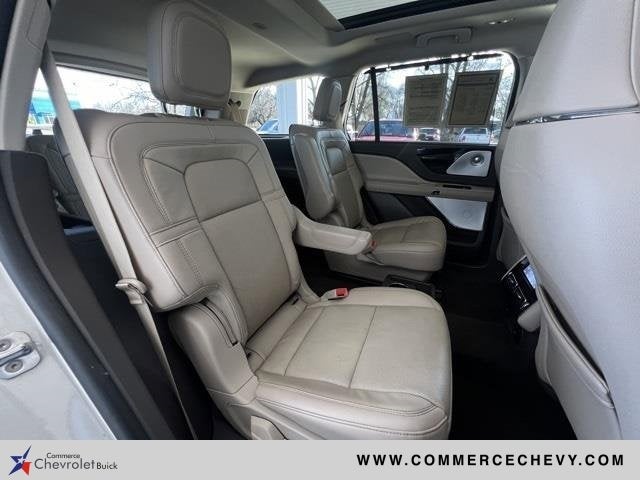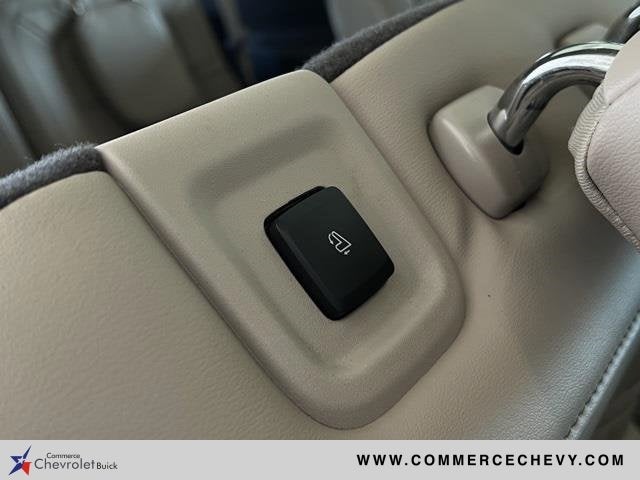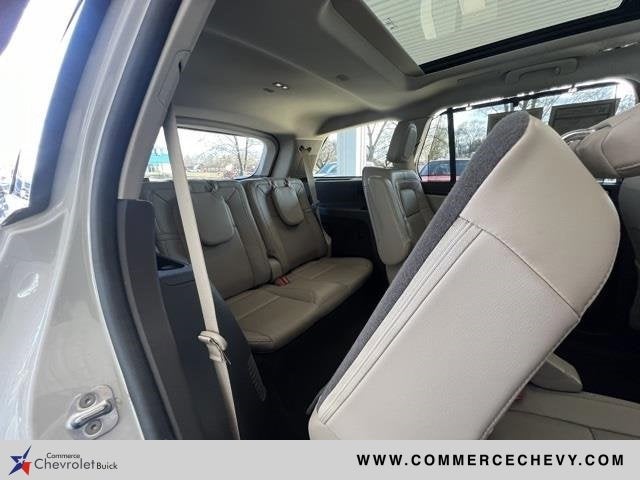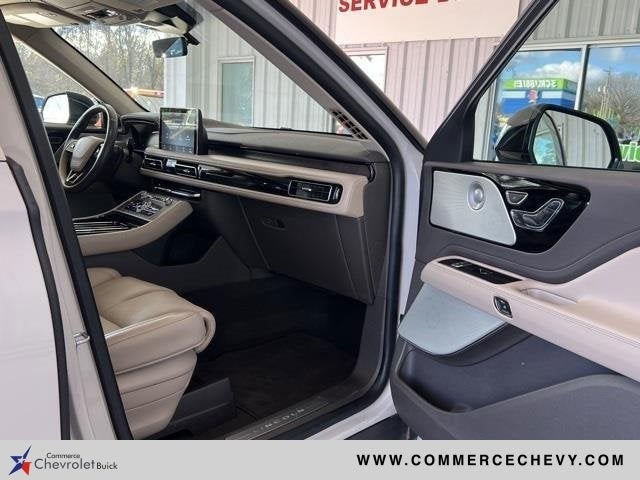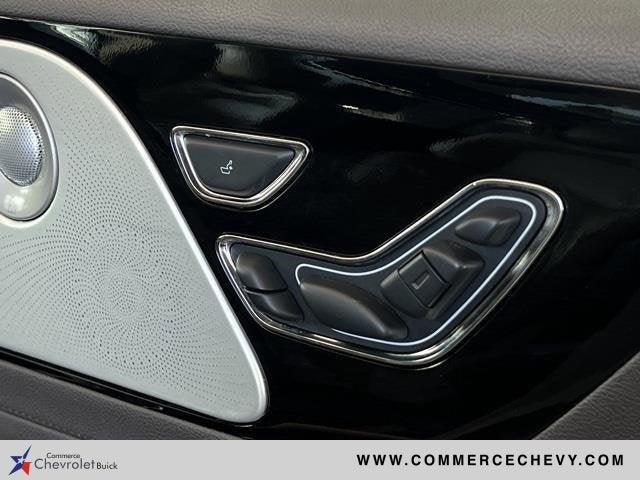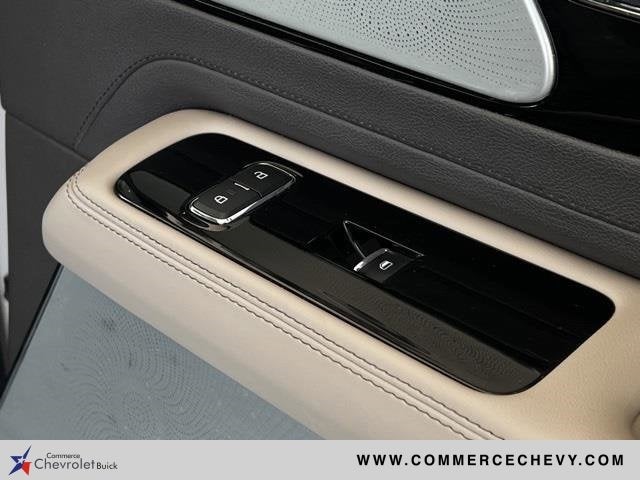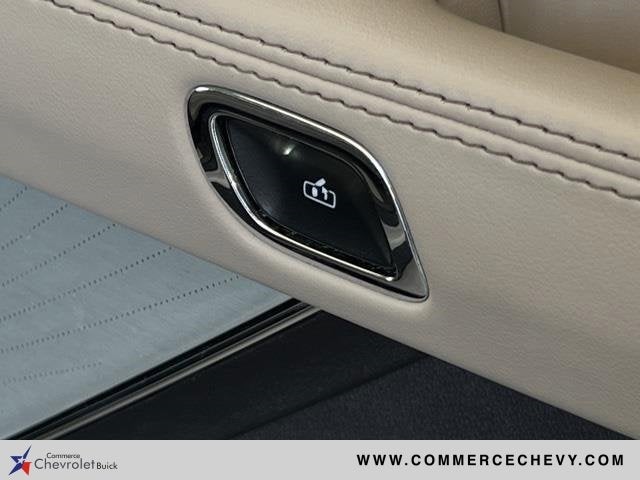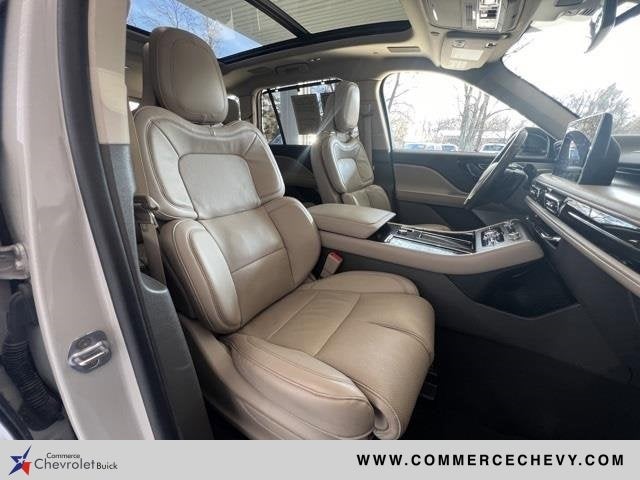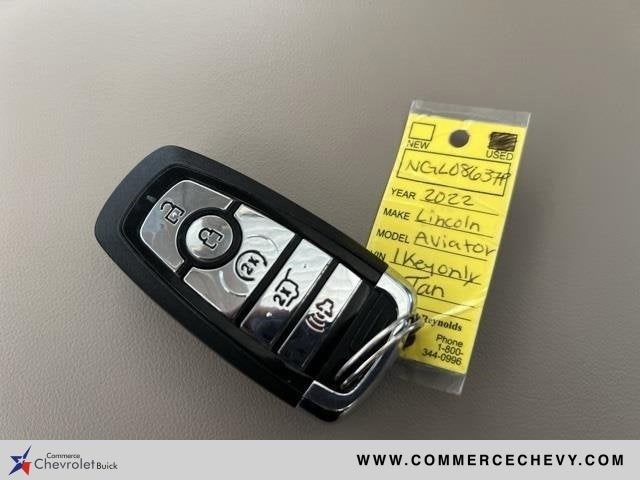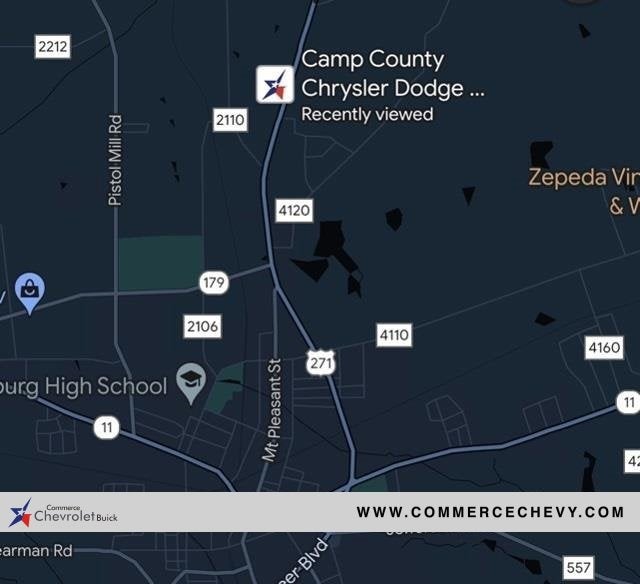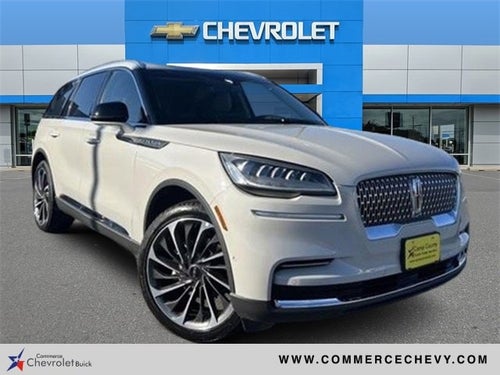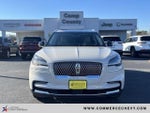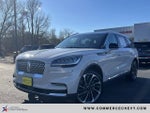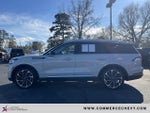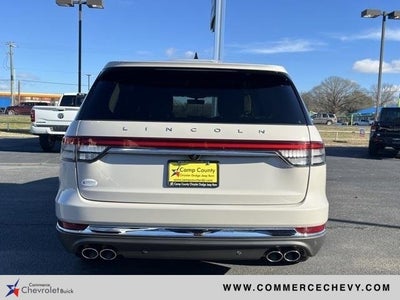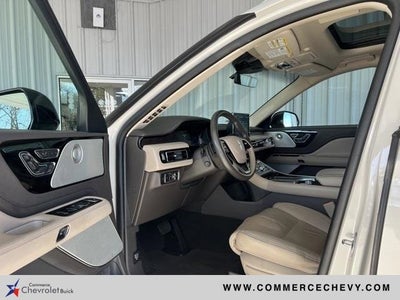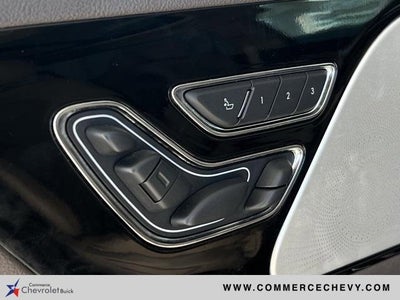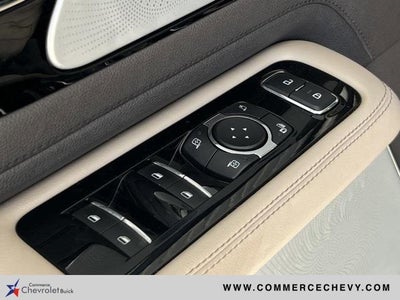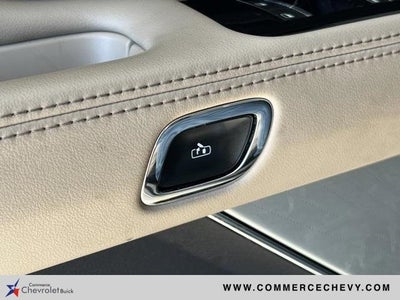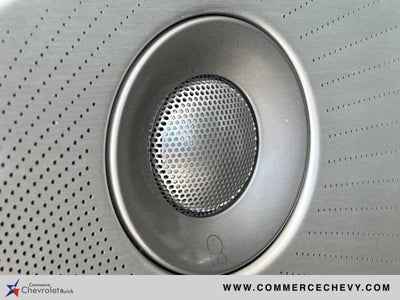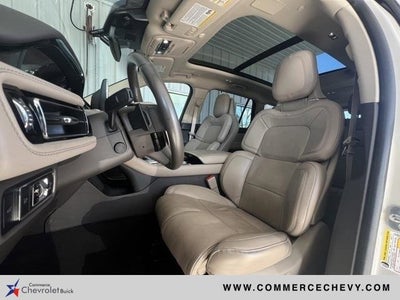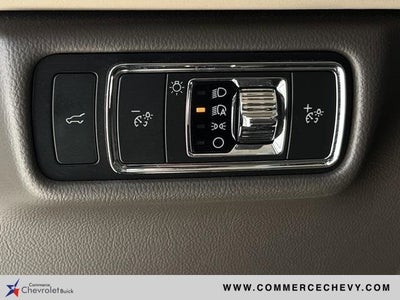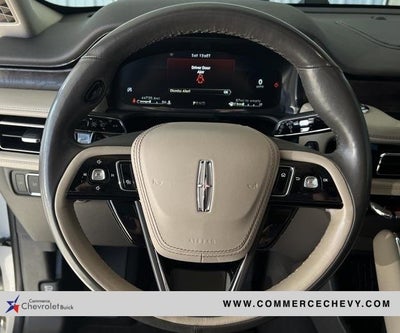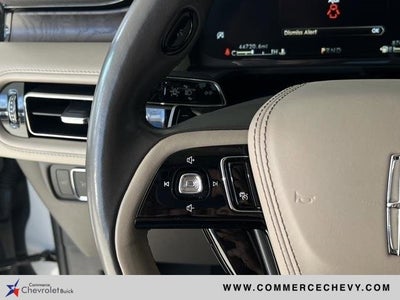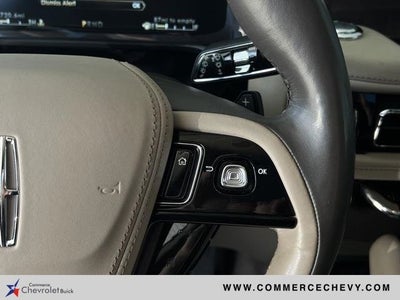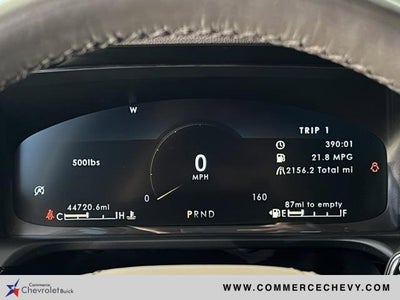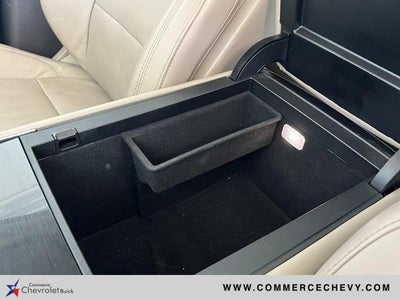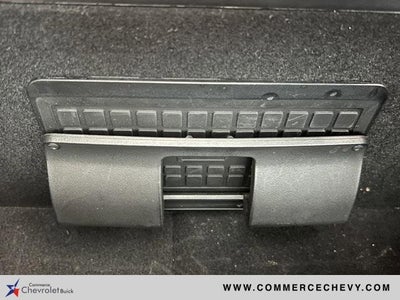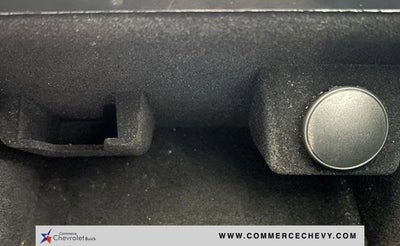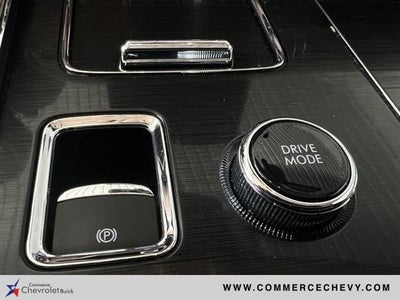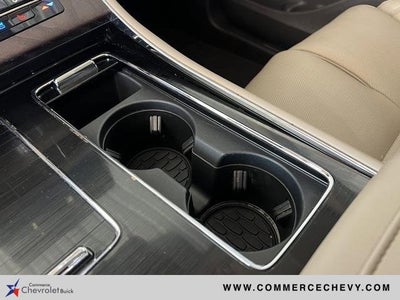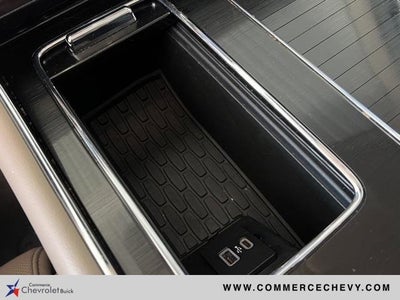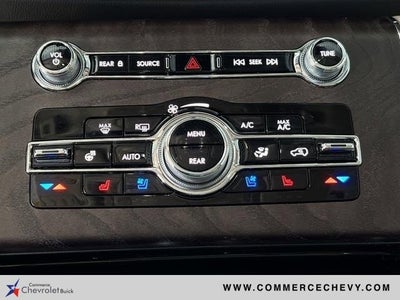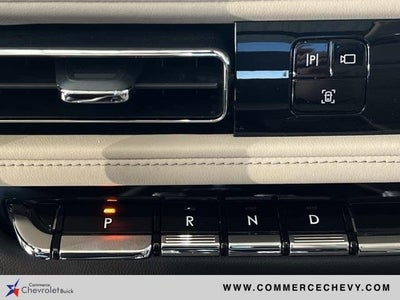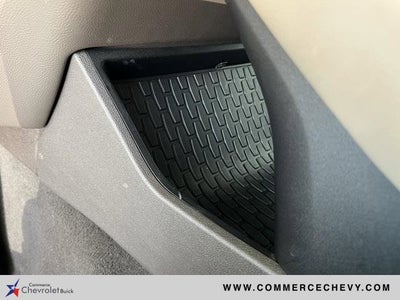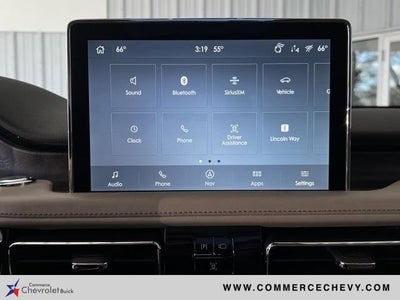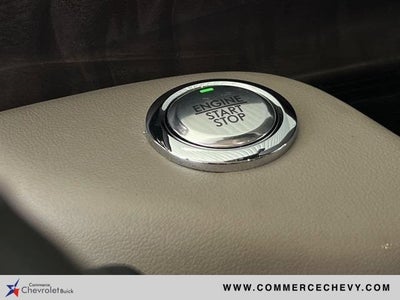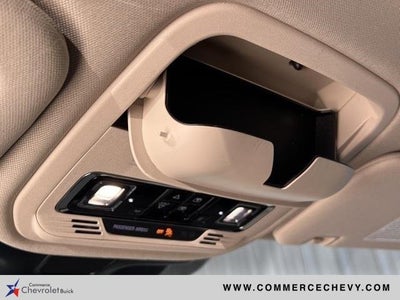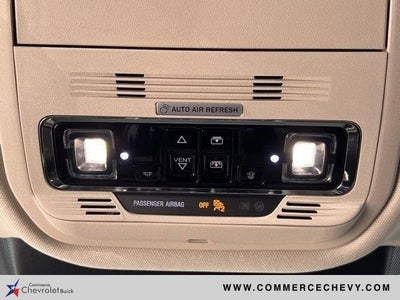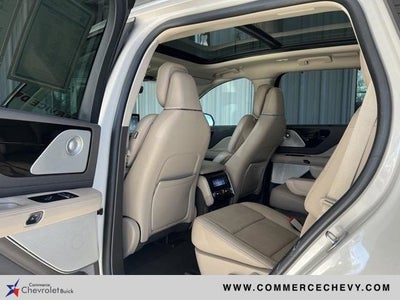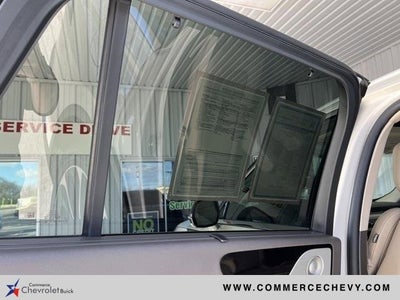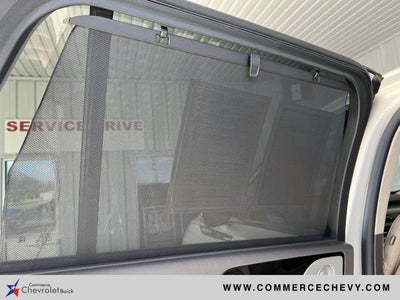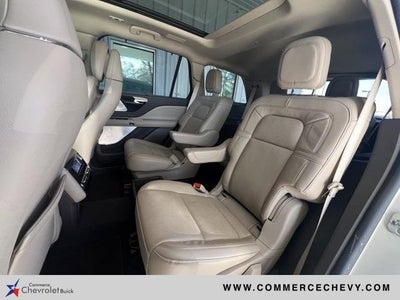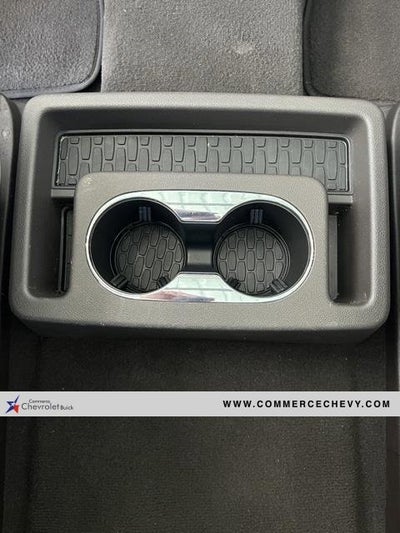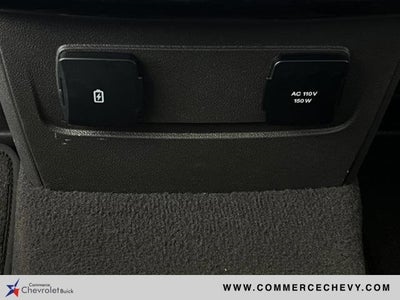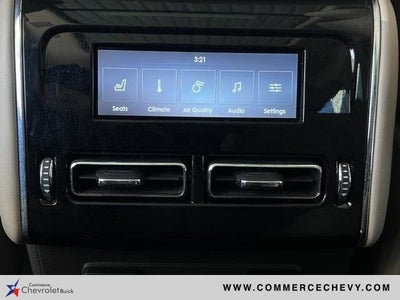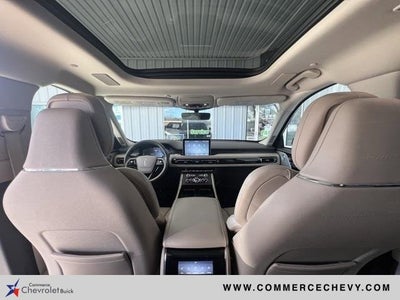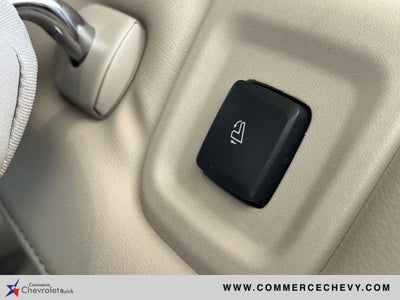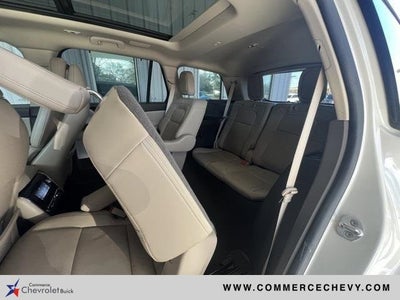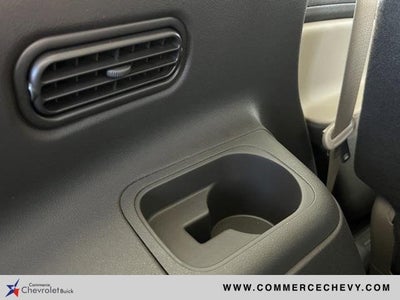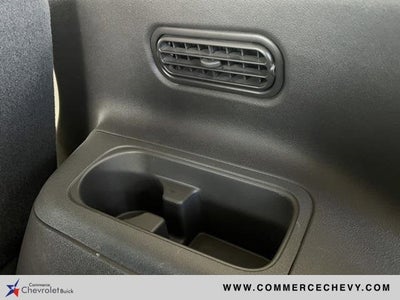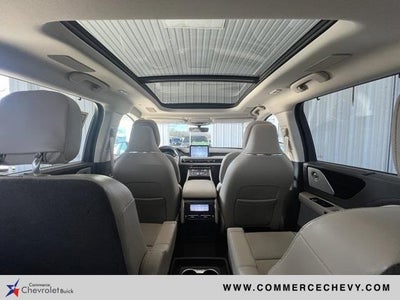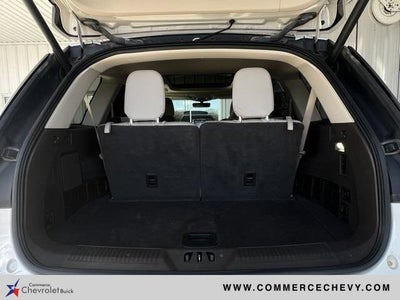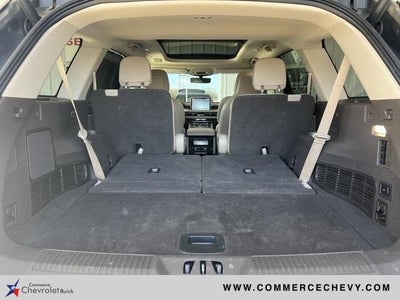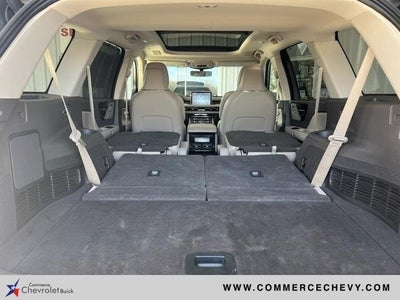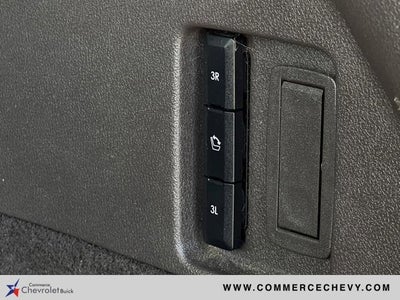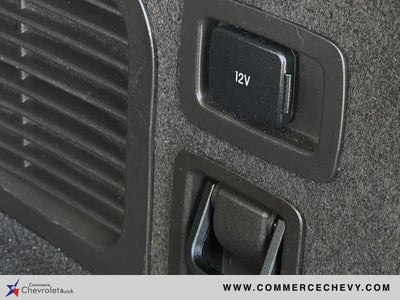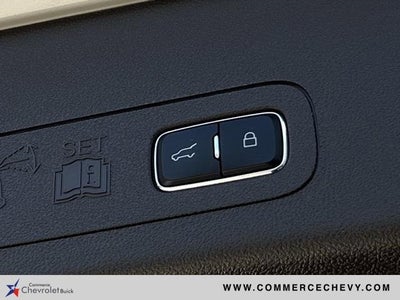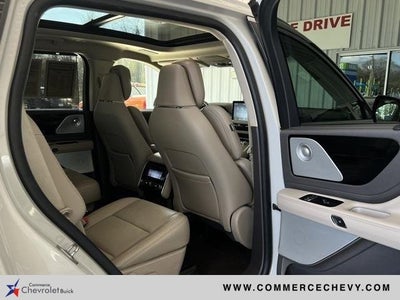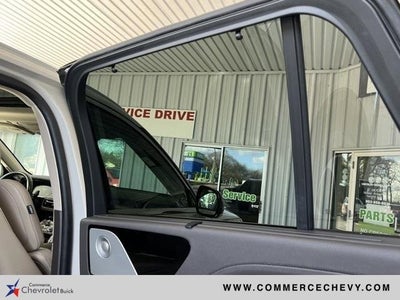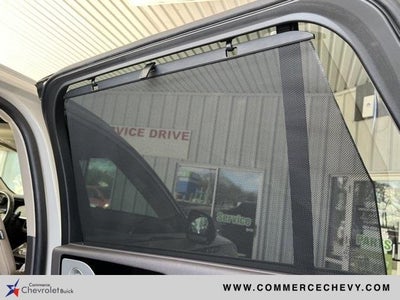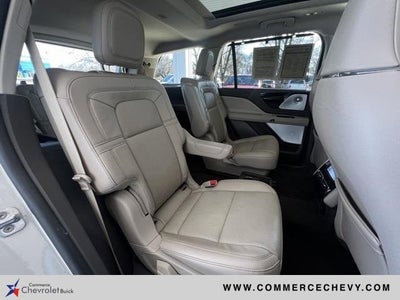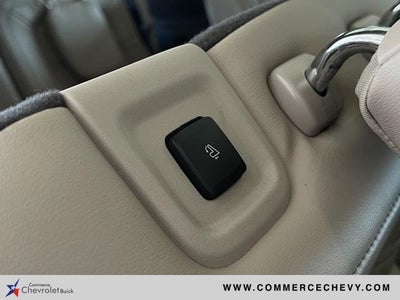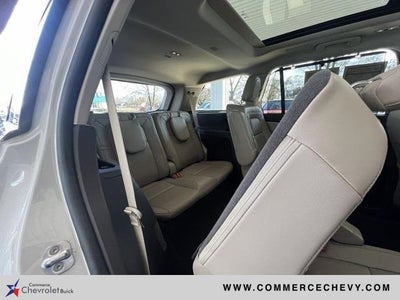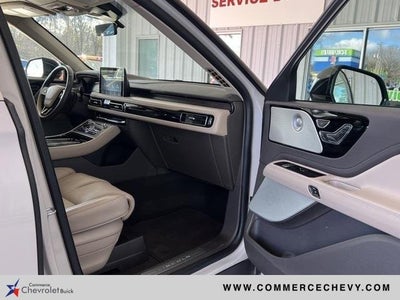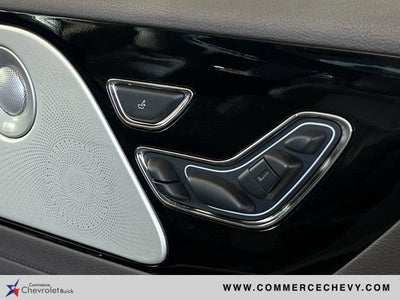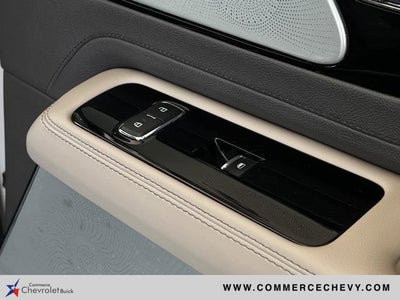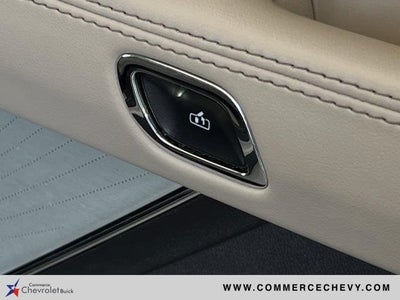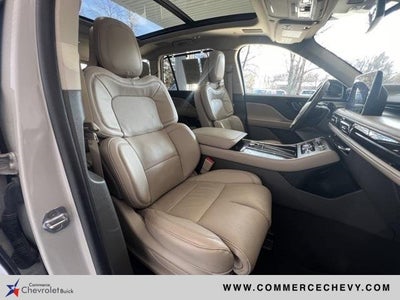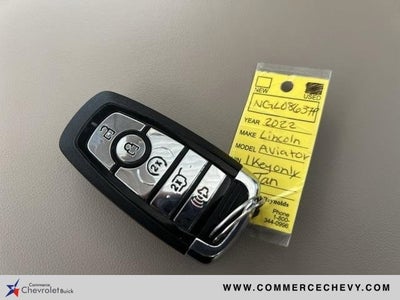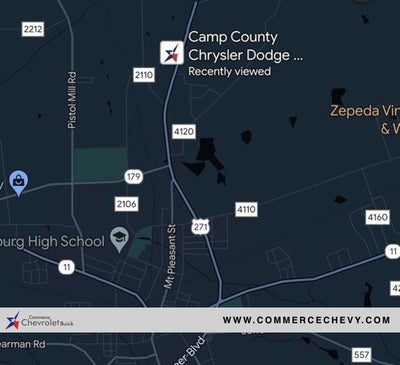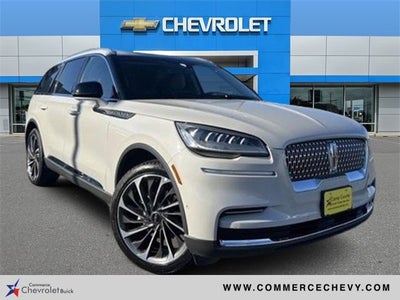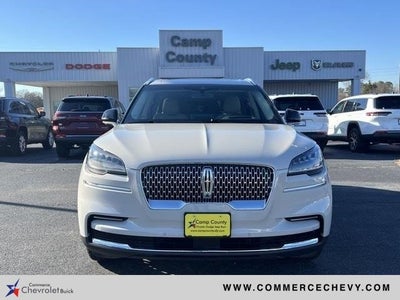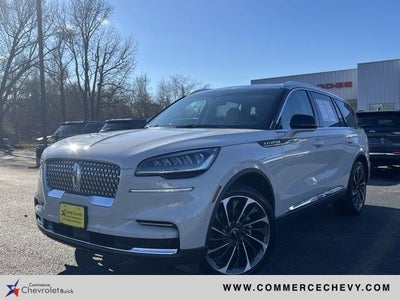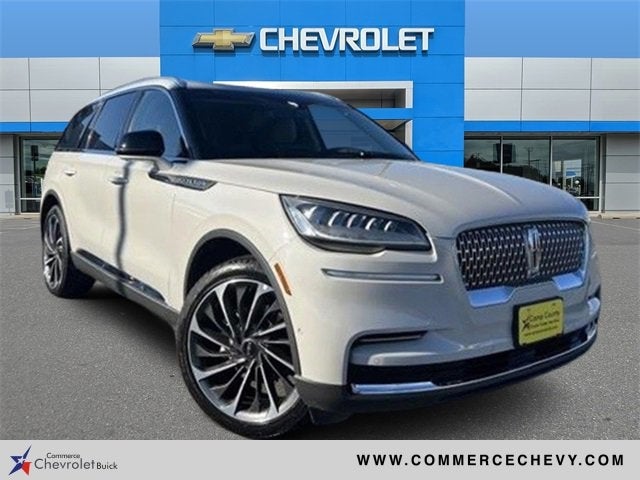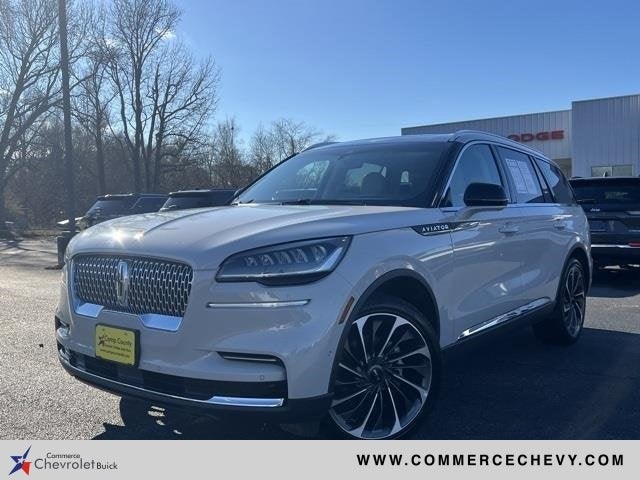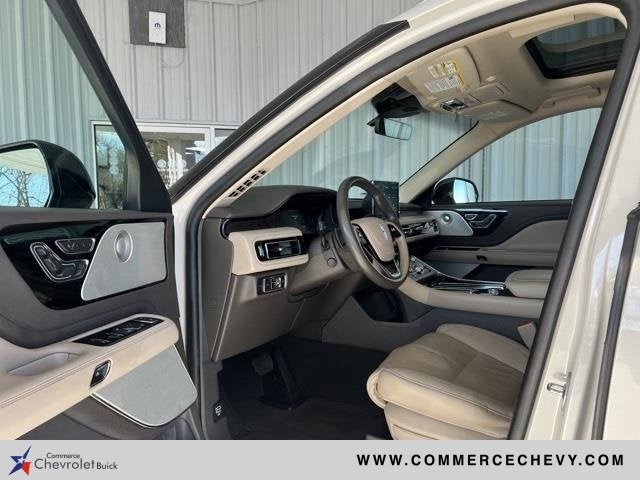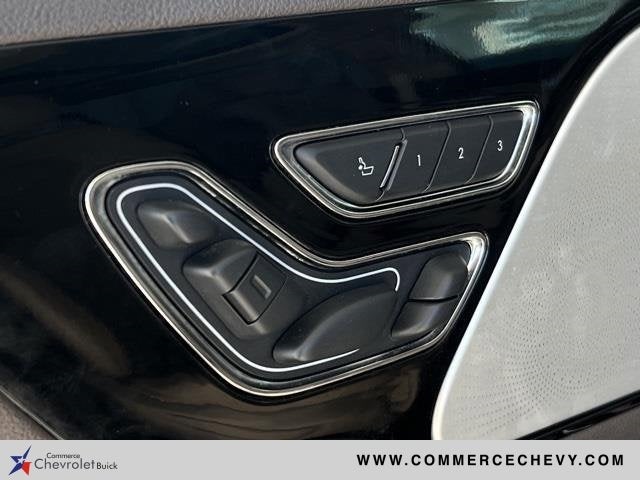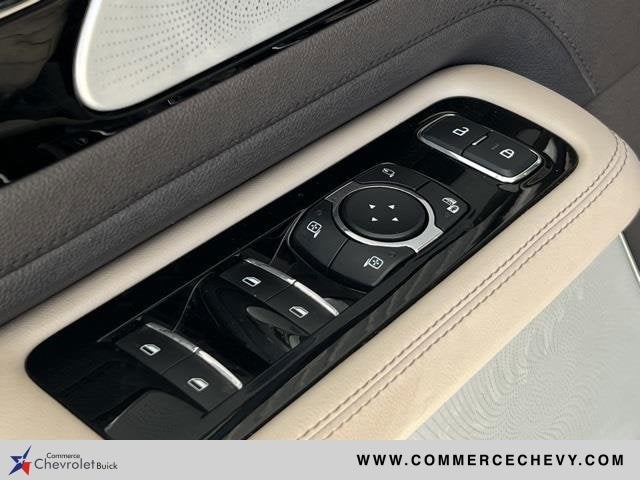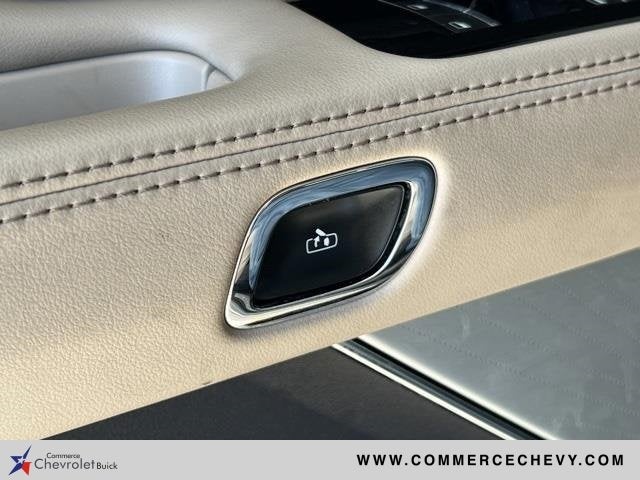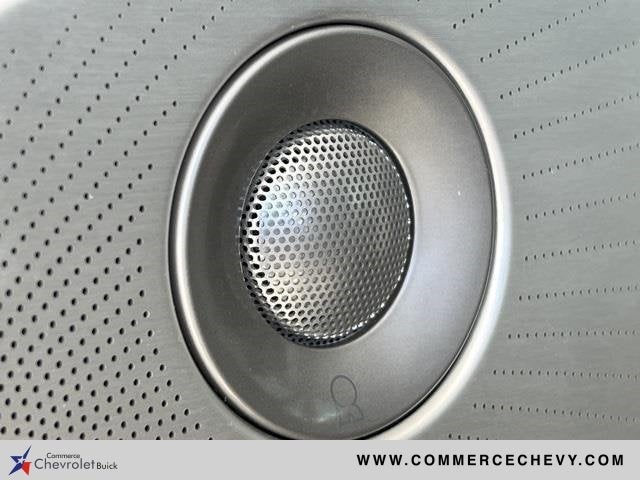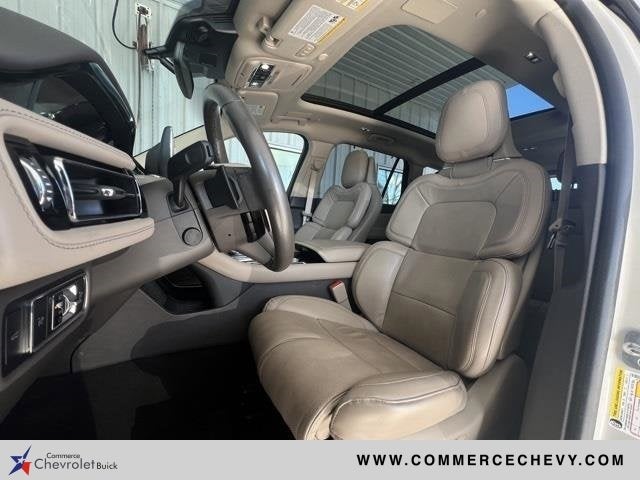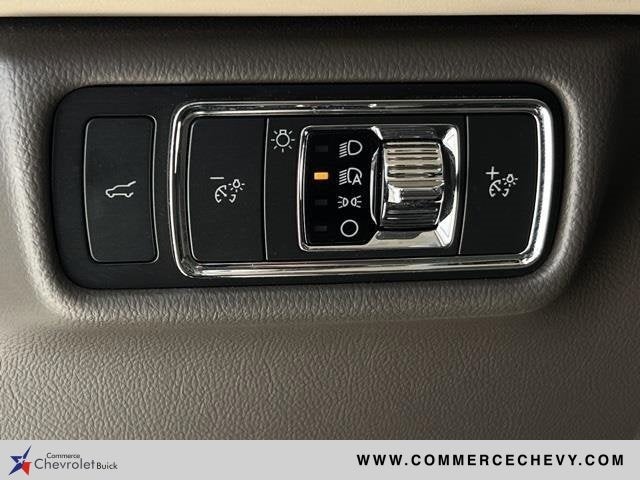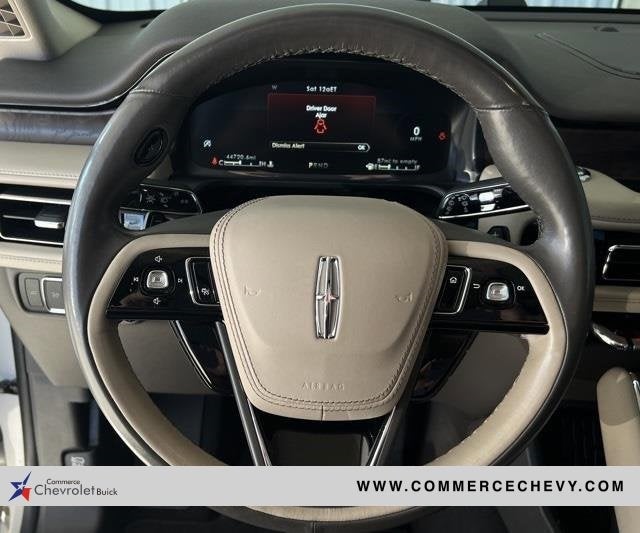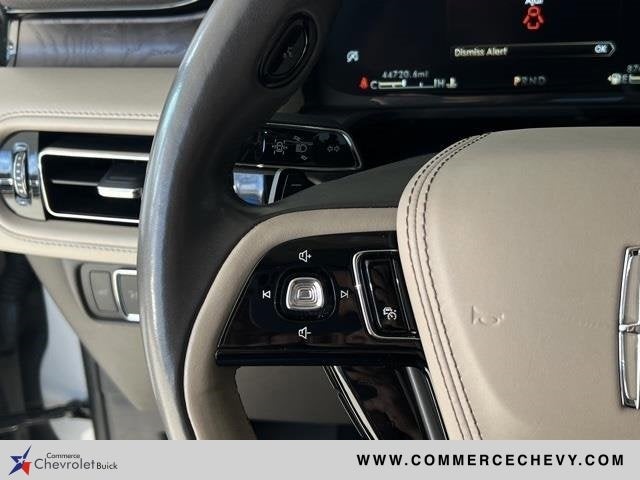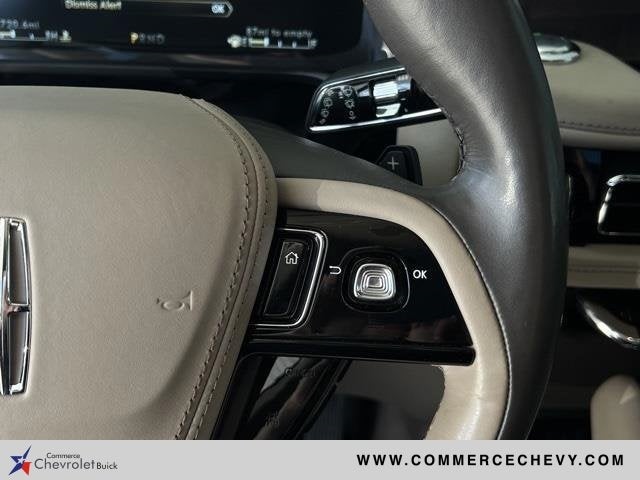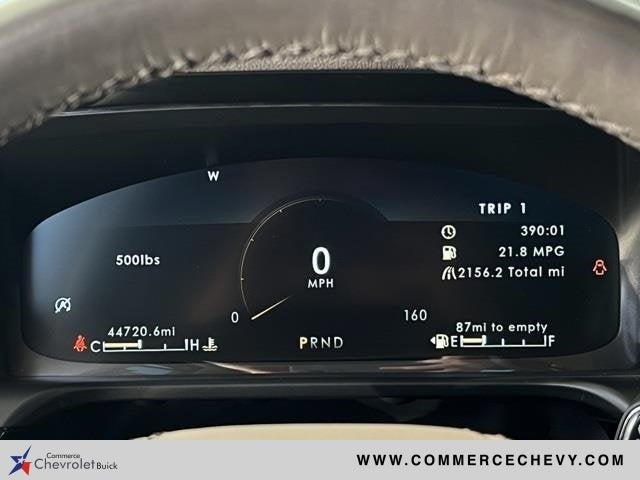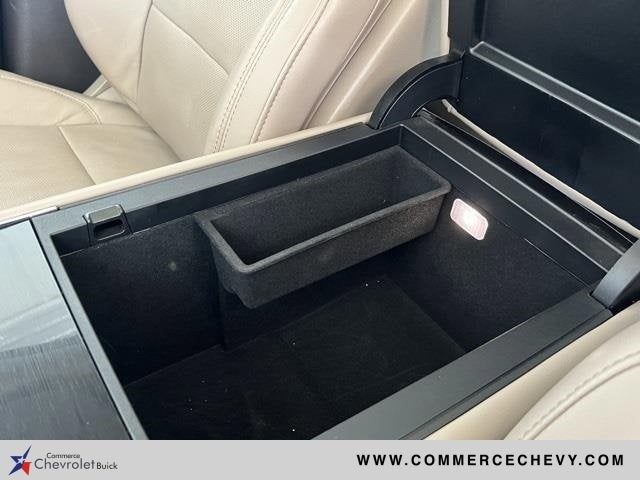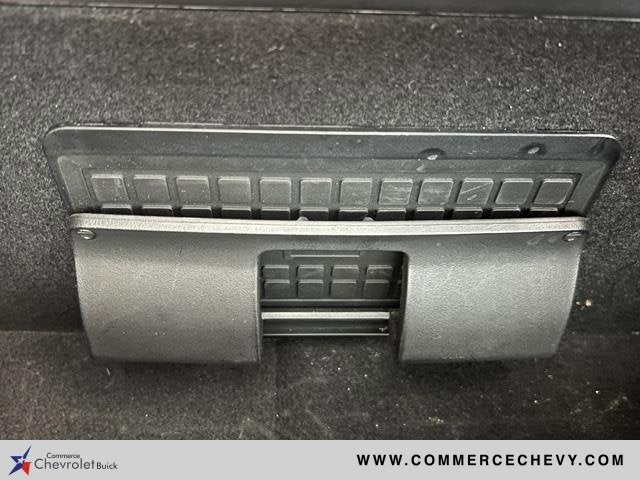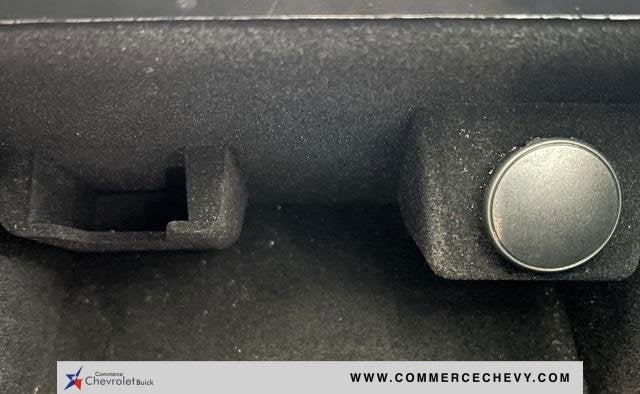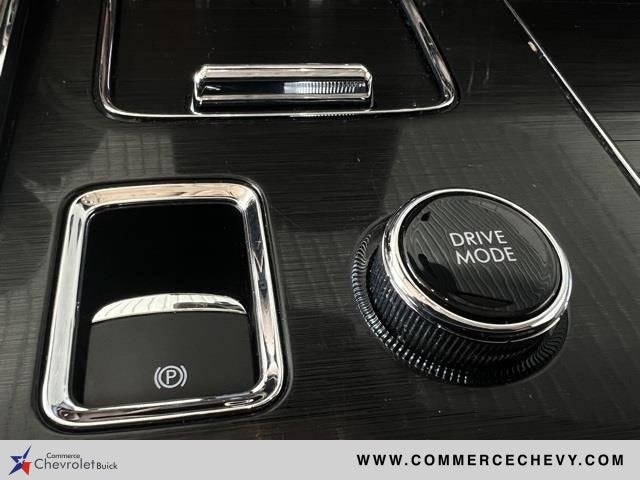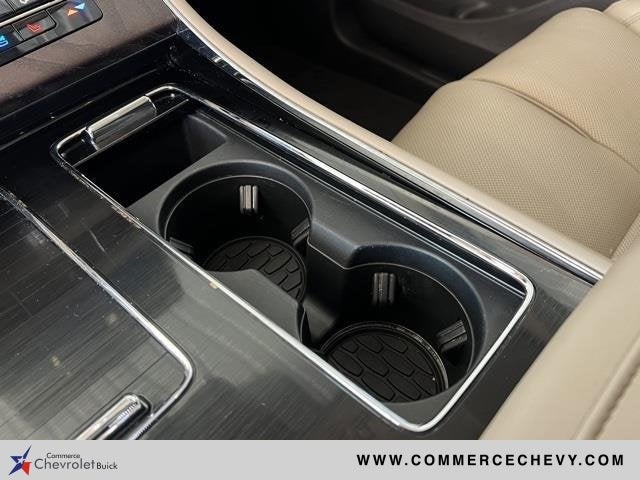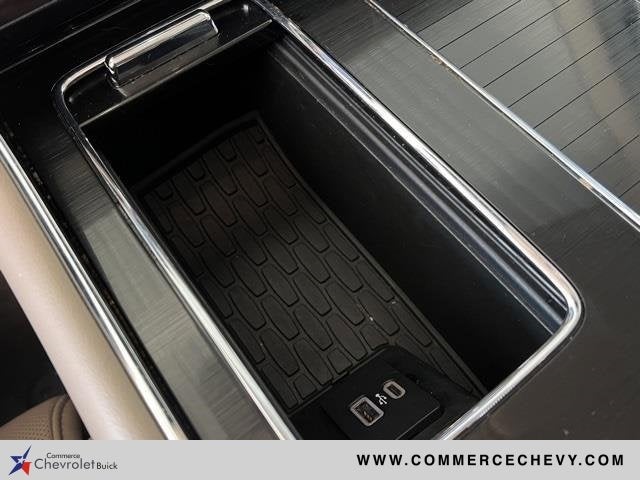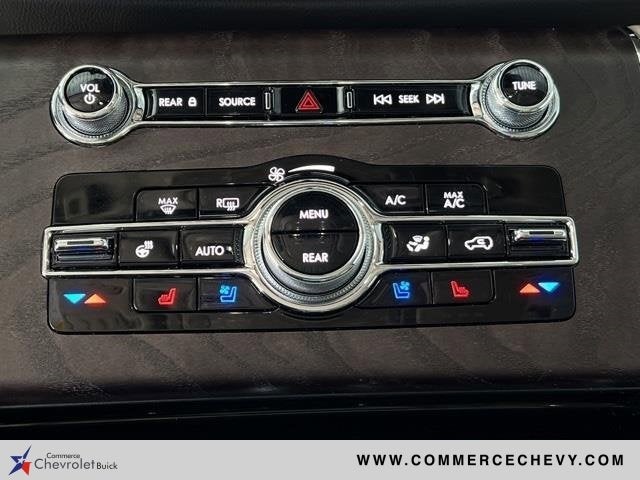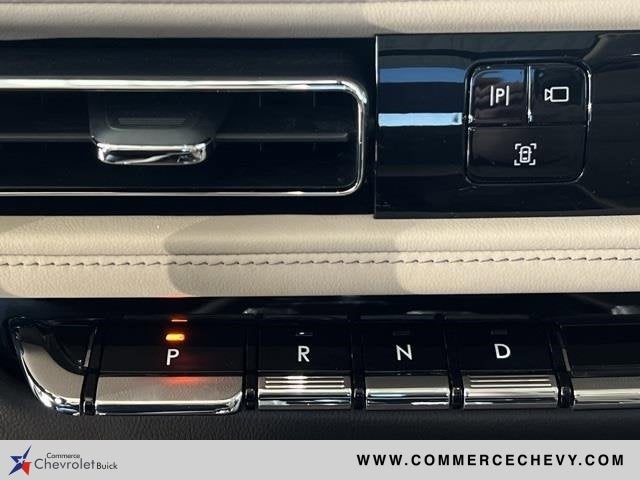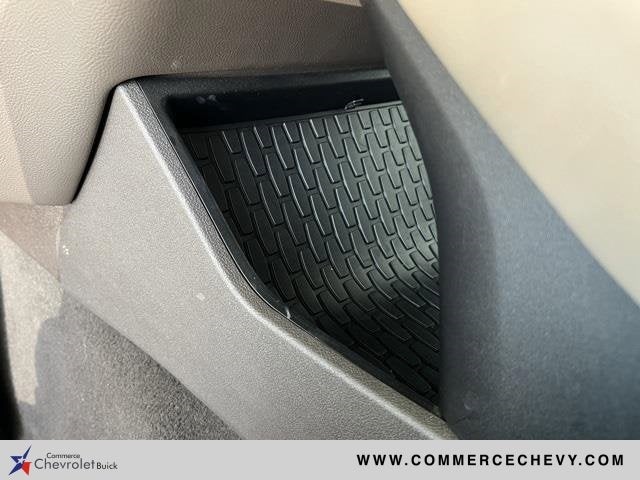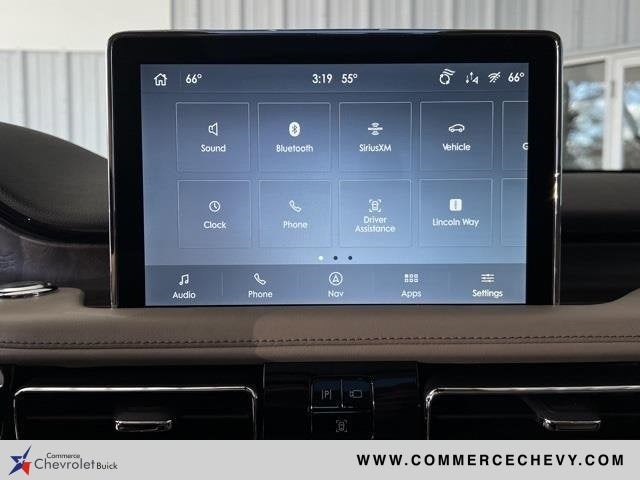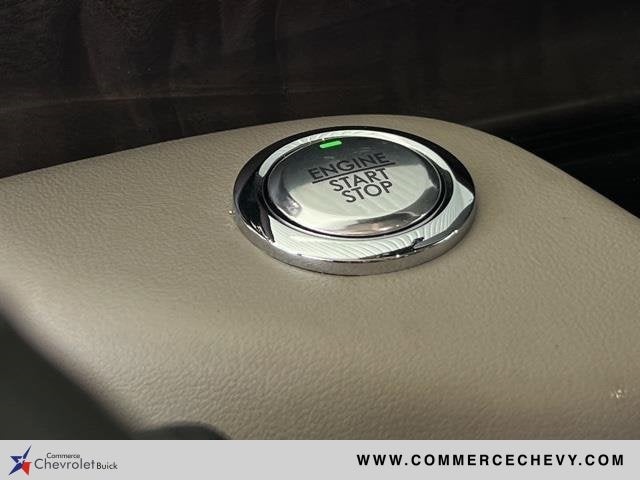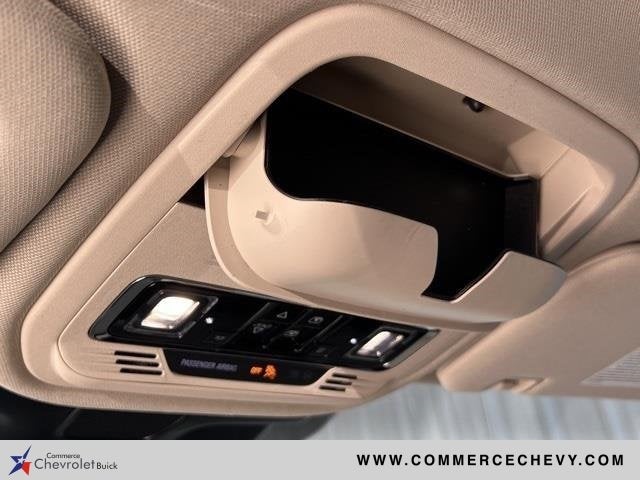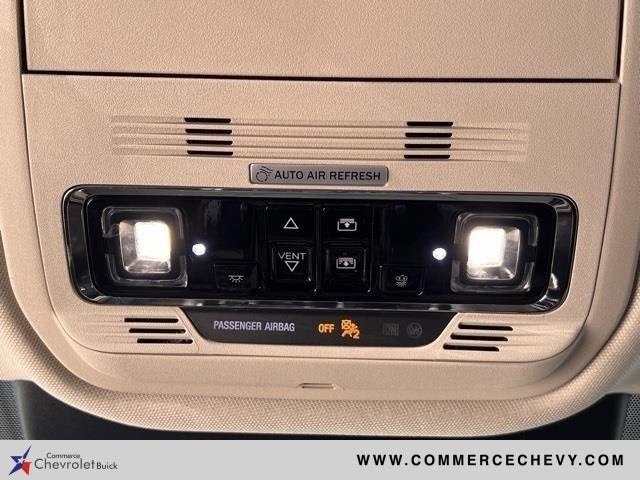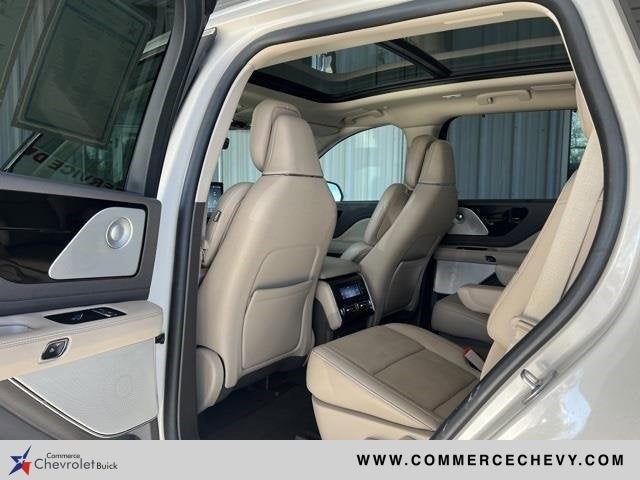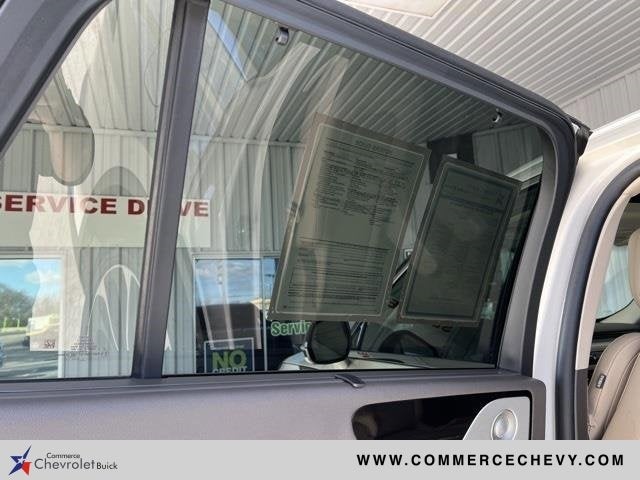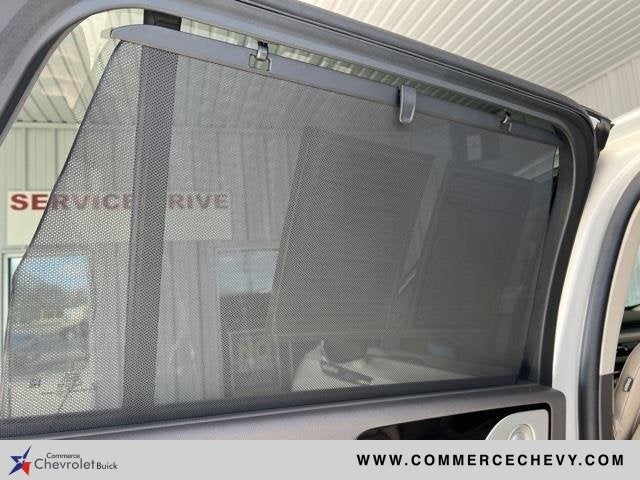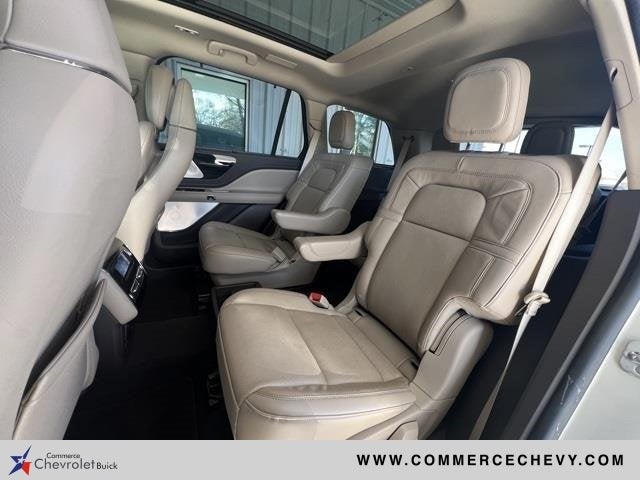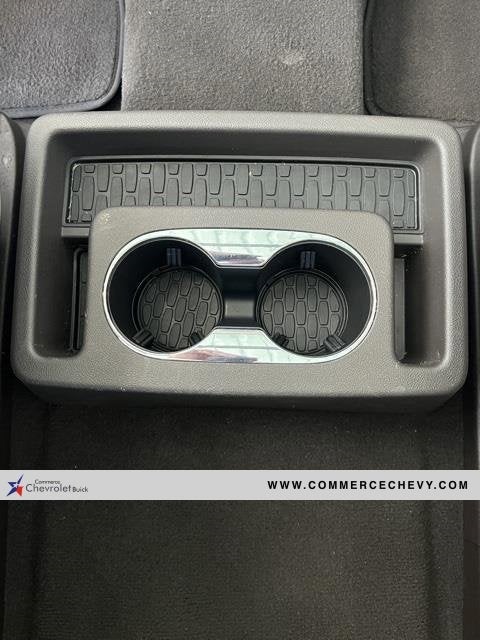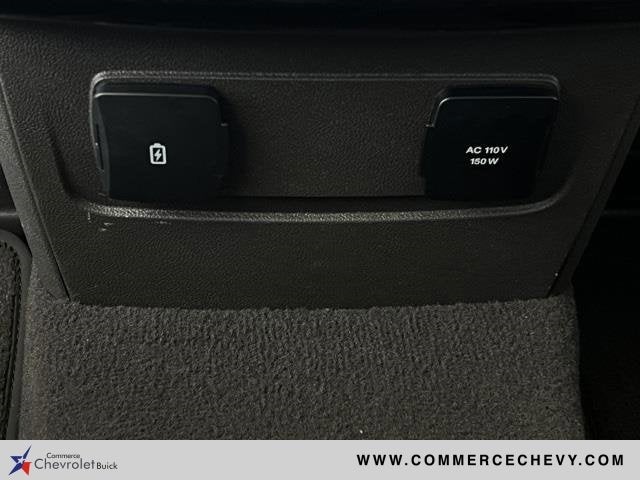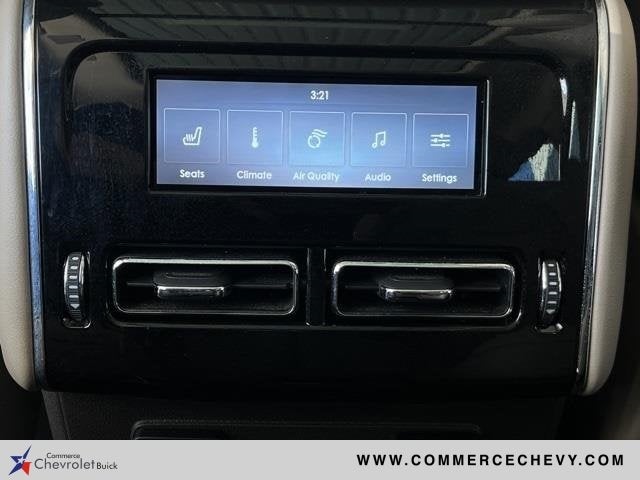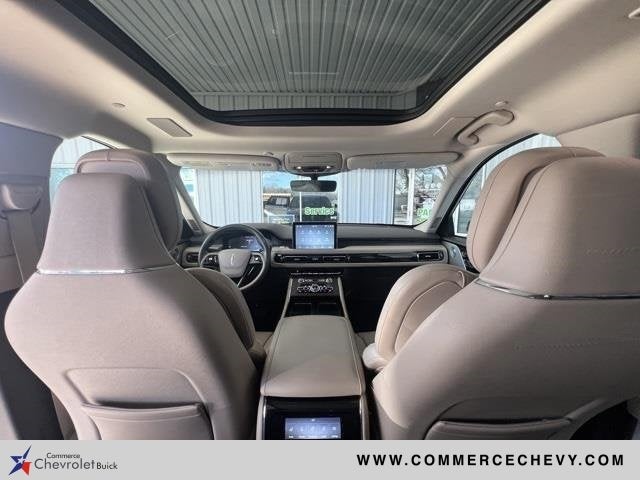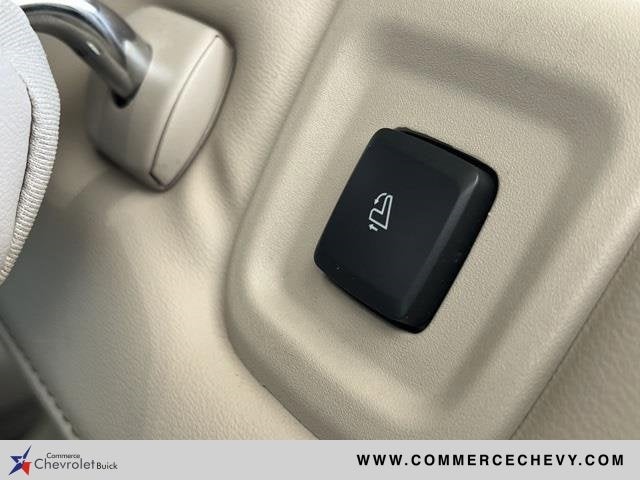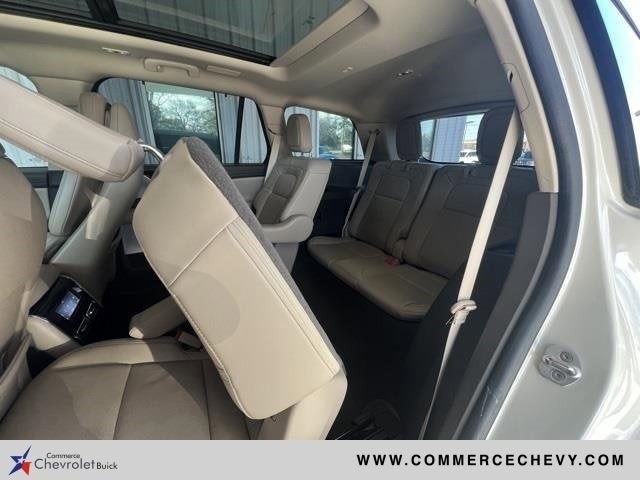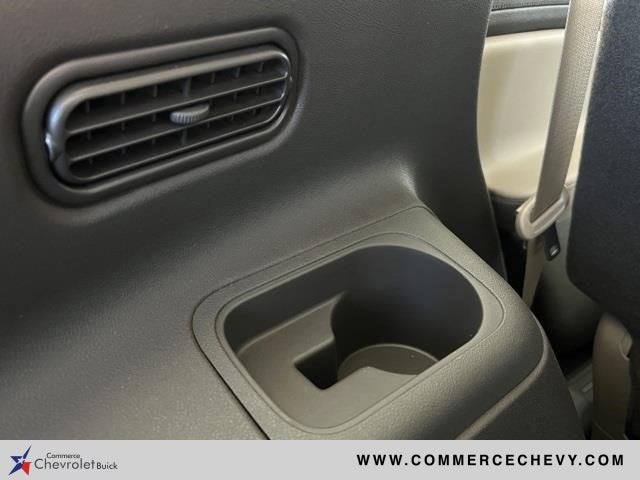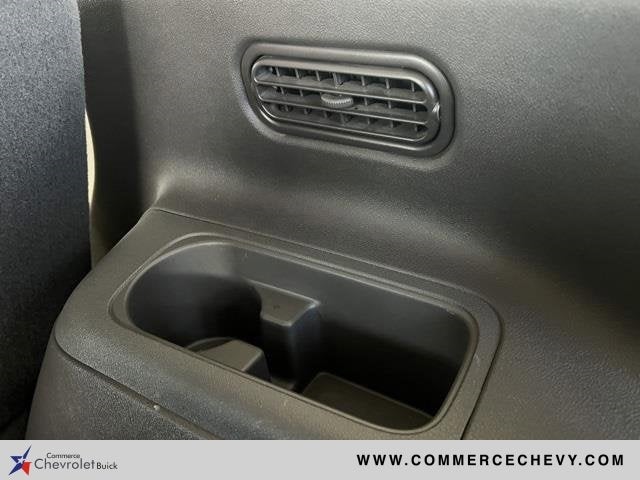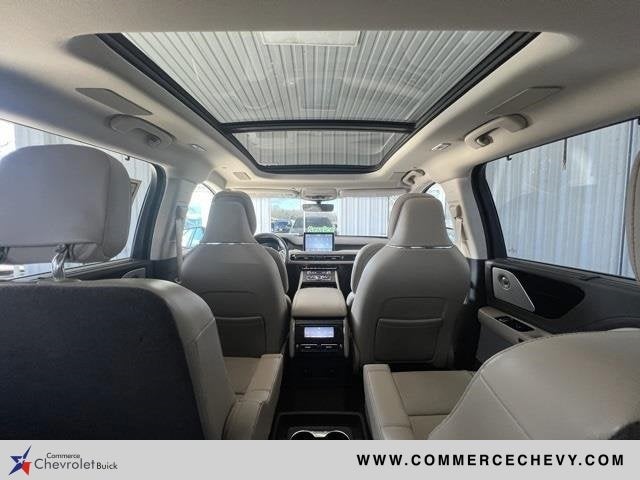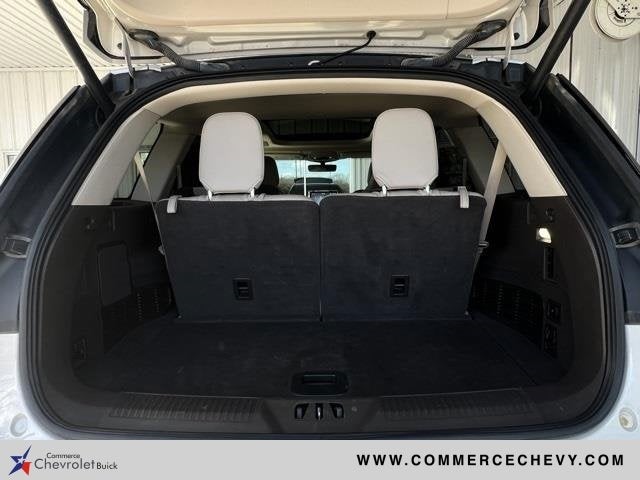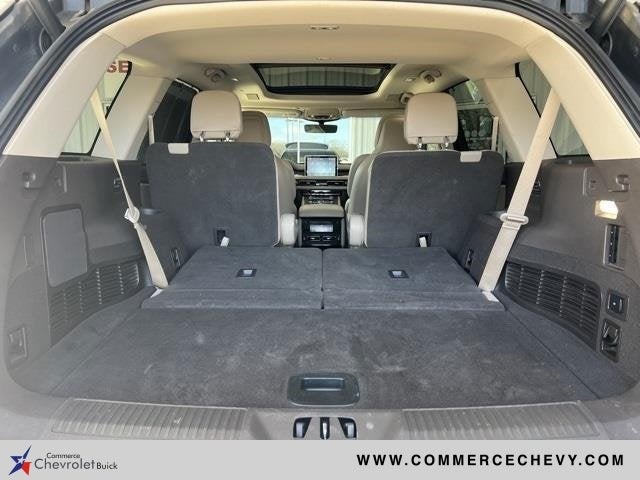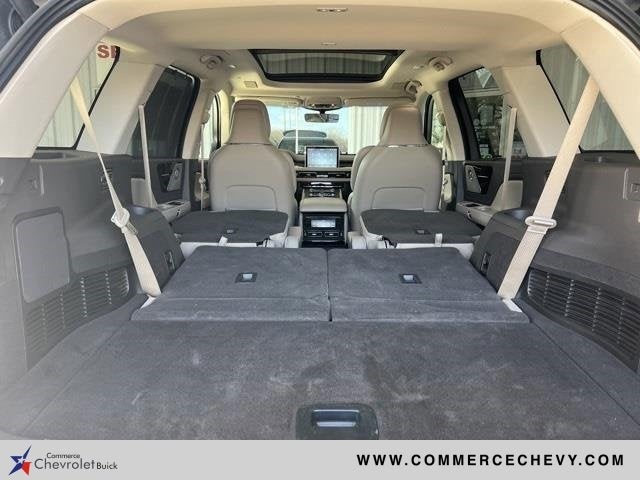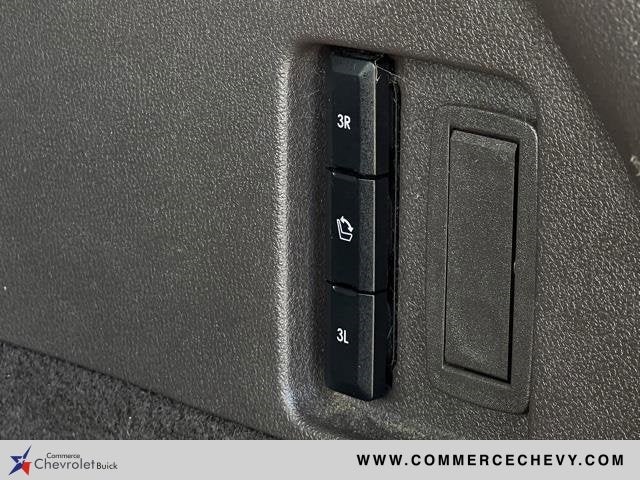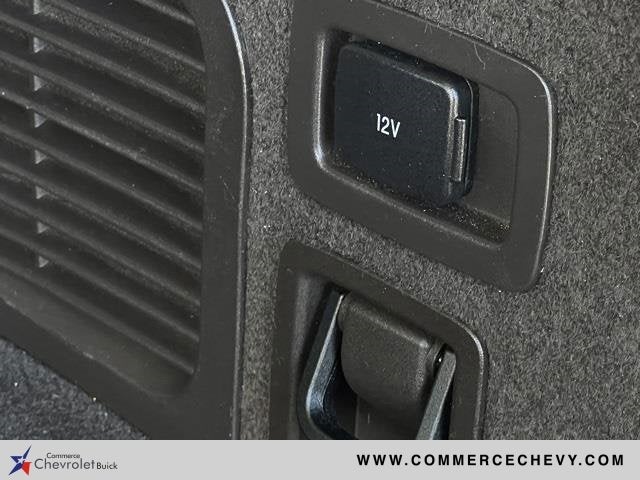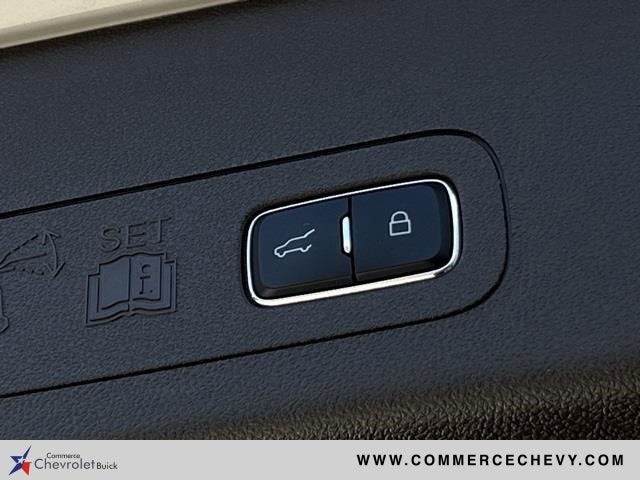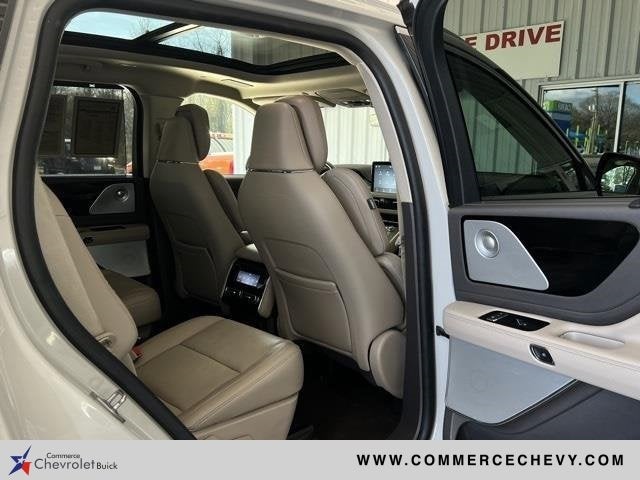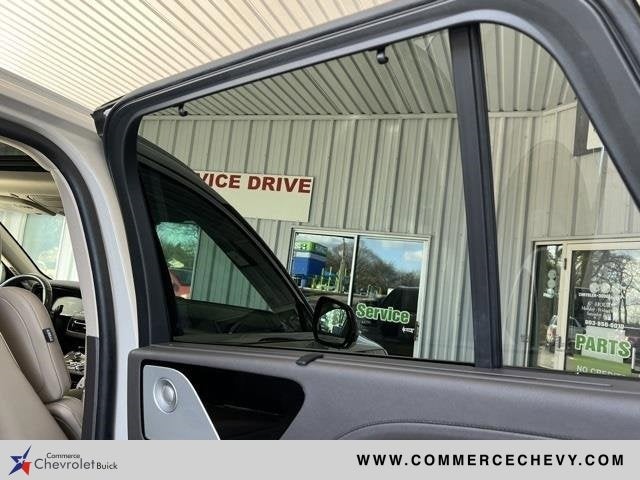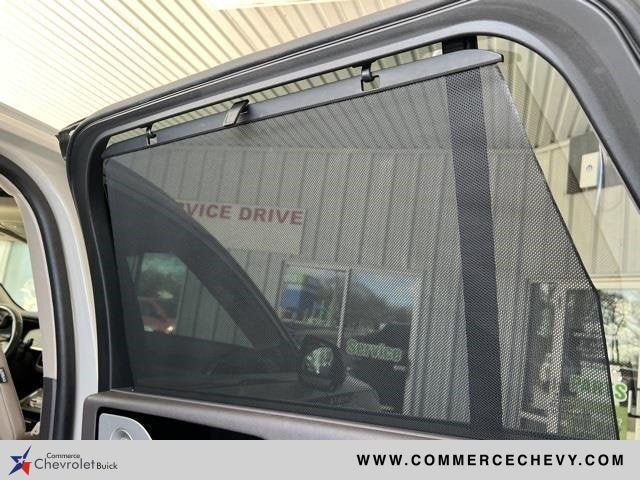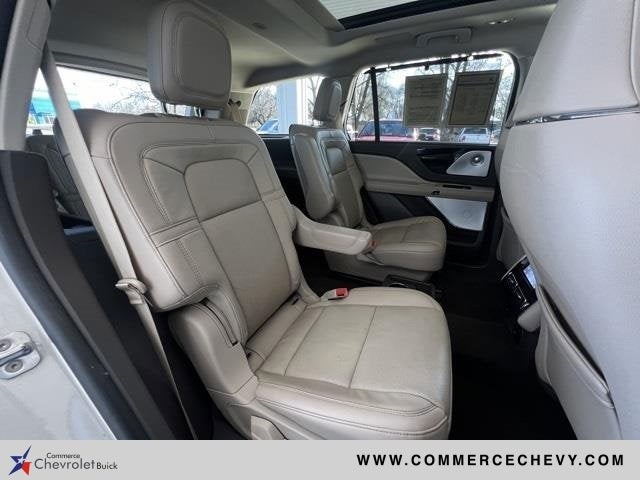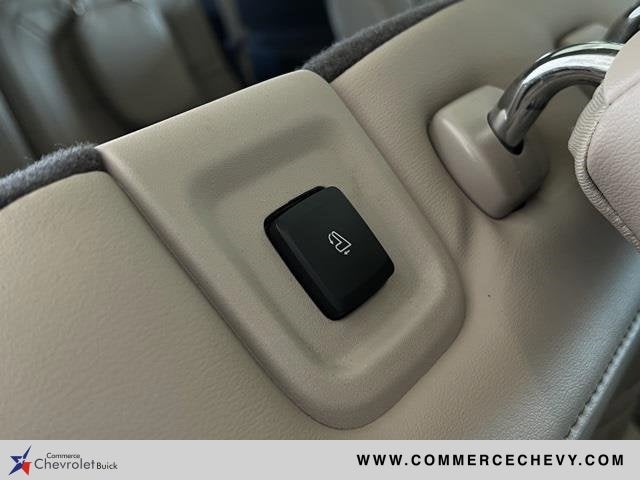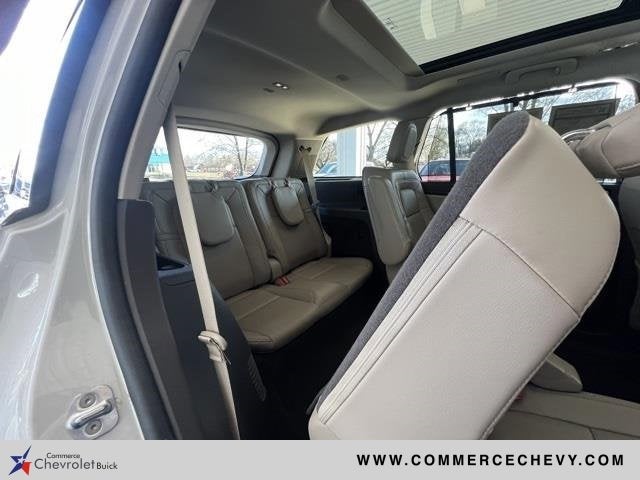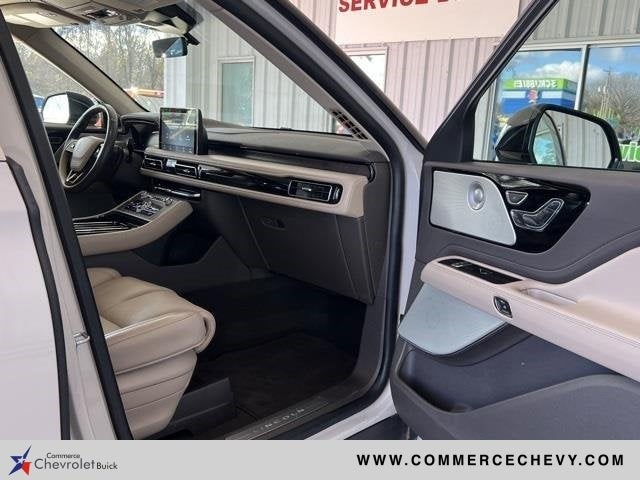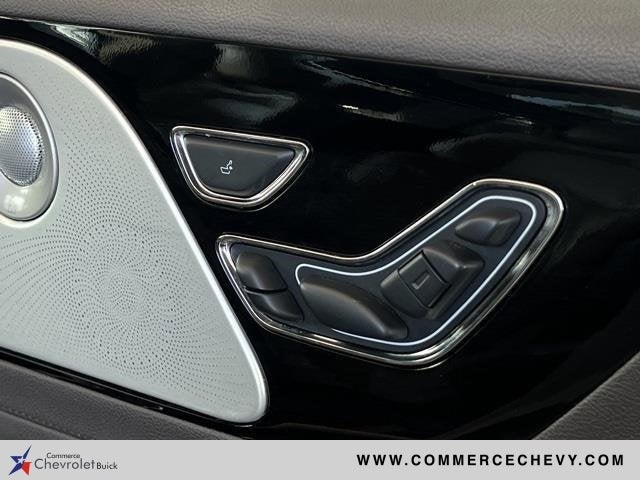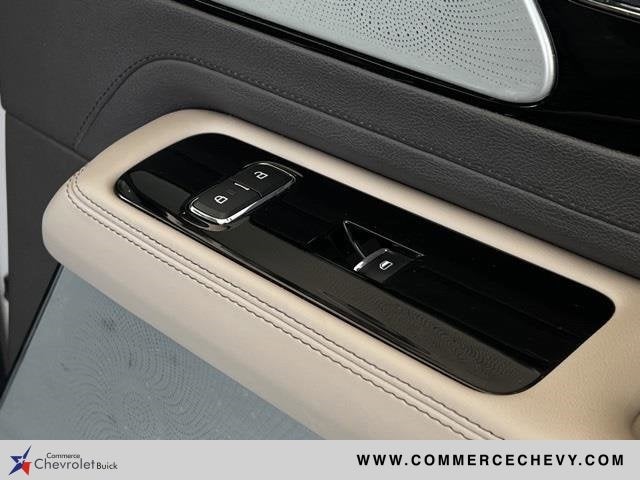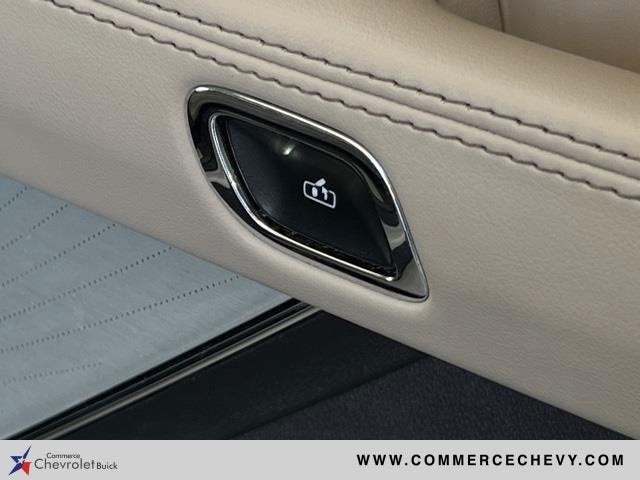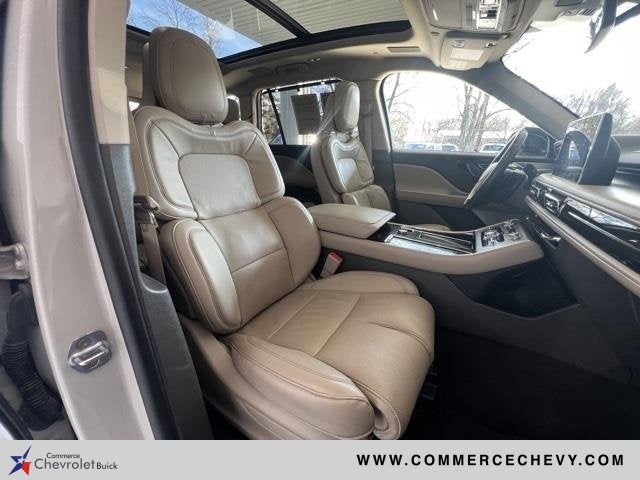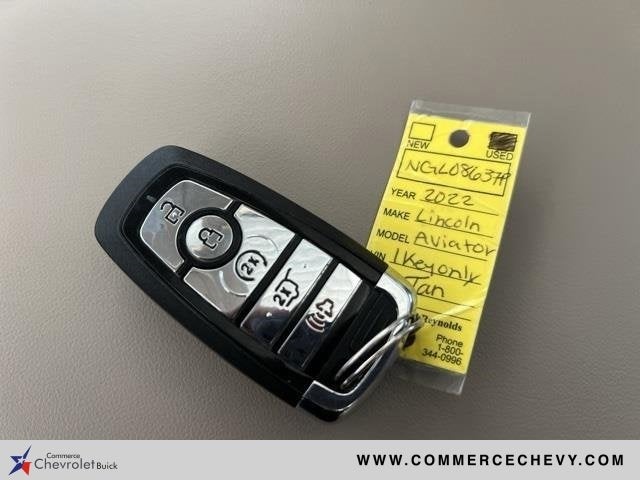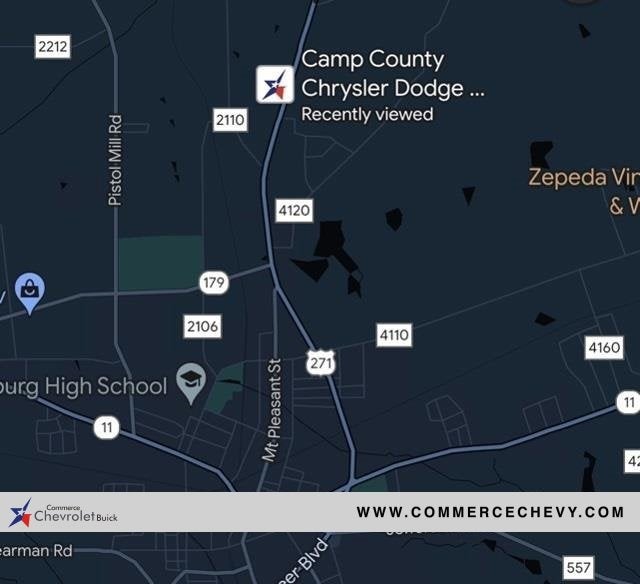Lifetime Warranty On All New Vehicles!Learn More!
Lifetime Warranty On All New Vehicles!Learn More!| Visit Our Group Site For More Vehicles.Click Here Now!
-
Lifetime Warranty On All New Vehicles!Learn More!
2022 Lincoln Aviator Reserve
Visit our Store
- Commerce Chevrolet
-
1621 State Highway 50
Commerce, TX 75428
- Sales: 903-246-4328
- Service: 903-568-7094
- Parts: 903-886-2188
- Body Shop: 903-886-2188
- Finance: 903-886-2188
Vehicle Information
VIN:
5LM5J7XC3NGL08637
Stock #:
NGL08637P
Model Code:
J7X
-
Condition Used
-
 Body Style Sport Utility
Body Style Sport Utility -
Exterior Color White
-
Interior Color Beige
-
Mileage 44,642
-
 Engine EcoBoost 3L V-6 gasoline direct injection, DOHC, variable valve control, twin turbo, premium unleaded, engine with 400HP
Engine EcoBoost 3L V-6 gasoline direct injection, DOHC, variable valve control, twin turbo, premium unleaded, engine with 400HP
Highlighted Features
Feature availability subject to final vehicle configuration.
- Adaptive Cruise Control
- Bluetooth®
- Heated Steering Wheel
- Remote Start
- Heated Seats
- Keyless Entry
- Keyless Ignition System
- Emergency Brake Assist
- Sunroof/Moonroof
- Blind Spot Monitor
- Forward Collision Warning
- Navigation System
- Parking Assistance
- Satellite Radio
- Speed Sensing Wipers
- Entertainment System
- Turbo Charged Engine
Dealer Comments
Thank you for shopping Commerce Chevy!
, **Lifetime Limited powertrain Warranty on ALL NEW VEHICLES**
, **125-Point Pre-Owned Inspection**
, **Non Commissioned Sales Staff**
, **Written Price Match Guarantee**
, **Factory Leasing Specials Available**
, **Free Chevy locating service**
, **GM Accessory Installation Center**
, **Pre-Owned Buying Center, you bring the title and receive your check same day**
, **GM Certified Service, Parts, and Bodyshop on site**
, **Prices do not include TTL, VIT, Doc Fees, Accessories, or destination charges**
.
, **Lifetime Limited powertrain Warranty on ALL NEW VEHICLES**
, **125-Point Pre-Owned Inspection**
, **Non Commissioned Sales Staff**
, **Written Price Match Guarantee**
, **Factory Leasing Specials Available**
, **Free Chevy locating service**
, **GM Accessory Installation Center**
, **Pre-Owned Buying Center, you bring the title and receive your check same day**
, **GM Certified Service, Parts, and Bodyshop on site**
, **Prices do not include TTL, VIT, Doc Fees, Accessories, or destination charges**
.
All Features
- Rear head restraint control: 2 rear seat head restraints
- Third-row head restraint number: 2 third-row head restraints
- Memory for 3 drivers: The seat(s) can be returned to a preset position at the touch of a button.
- 50-50 split folding third-row seats: The third-row seatback is split, allowing one or both sides to be folded down.
- Seating capacity: 6
- Console insert material: Aluminum console insert
- Automatic air conditioning: Automatic air conditioning is a completely integrated electronic system. The system automatically adjusts thermostat and fan settings as needed to maintain a preset temperature. The system may also be operated manually when preferred.
- Auxiliary rear heater: An auxiliary rear heater is a completely independent heating system for the rear passenger compartment.
- Bucket front seats: Separate driver and front passenger seats with individual control are provided.
- Cabin air filter: A system that filters the air before it enters the passenger compartment of the vehicle.
- Carpet front and rear floor mats: Front and rear carpeted floor mats are included.
- Rear seatback upholstery: Carpet rear seatback upholstery
- Third-row seatback upholstery: Carpet third-row seatback upholstery
- Headliner material: Cloth headliner material
- Deep tinted windows: Some of the vehicle's glass has a dark, privacy tint.
- Power 4-way driver lumbar: Lumbar support is power adjustable in and out, as well as up and down.
- 22-way driver seat: The seat provides a variety of adjustments to enhance seating comfort.
- Power 4-way driver lumbar: Lumbar support is power adjustable in and out, as well as up and down.
- Dual zone front HVAC controls: Dual zone HVAC provides separate temperature controls for the driver and front passenger.
- Dual zone rear HVAC controls: The rear HVAC system includes separate left/right climate controls.
- Rear seats fixed or removable: Fixed second-row seats
- Third-row head restraints: Fixed third-row head restraints
- Third-row seat fixed or removable: Fixed third-row seats
- Third-row seat facing: Front facing third-row seat
- 22-way passenger seat: The seat provides a variety of adjustments to enhance seating comfort.
- Power 4-way front passenger lumbar: Lumbar support is power adjustable in and out, as well as up and down.
- Front seat center armrest: A single center armrest divides the front seating positions.
- Full floor coverage: The entire passenger compartment floor is covered with flooring material.
- Full floor coverage: The entire passenger compartment floor is covered with flooring material.
- Headliner coverage: Full headliner coverage
- Heated driver and front passenger seatbacks: Heated seats offer cool weather comfort by warming the seat quickly, before the air in the passenger compartment is fully warmed by the heater.
- Heated rear seats: Heated seats offer cool weather comfort by warming the seat quickly, before the air in the passenger compartment is fully warmed by the heater.
- Heated steering wheel: The steering wheel rim is heated.
- Height adjustable rear seat head restraints: The head restraint(s) can be adjusted up or down.
- Height and tilt adjustable front seat head restraints: The head restraint(s) can be adjusted up or down as well as back and forth.
- Laminated side glass: Laminated glass is comprised of two pieces of glass with a layer of plastic sandwiched between them.
- Leather seat upholstery: The seating surfaces are covered in leather.
- Leather rear seat upholstery: The seating surfaces are covered in leather.
- Leather wrapped steering wheel: The steering wheel rim is wrapped in leather.
- Leatherette door trim: The door trim insert is leatherette.
- Front seatback upholstery: Leatherette front seatback upholstery
- Dashboard material: Leatherette upholstered dashboard
- Leatherette third-row seat upholstery: The seating surfaces are covered in leatherette.
- Rear head restraint control: Manual rear seat head restraint control
- Manual rear side sunblinds: A manually operated, retractable, privacy/sun shade, mounted inside, that covers any of the vehicle's rear side windows.
- Manual reclining rear seat: The seatback angle is manually adjustable.
- Interior accents: Metal-look interior accents
- Power passenger seat cushion tilt: The angle of the seat cushion can be power tilted up/down.
- Panel insert: Piano black and aluminum instrument panel insert
- Door panel insert: Piano black door panel insert
- Power front seat head restraints: The head restraints are adjustable electrically.
- Power telescopic steering wheel: The steering wheel's telescoping adjustment is electrically motorized.
- Power tilt steering wheel: The steering wheel angle adjustment is electrically motorized.
- Rear HVAC with separate controls: Rear HVAC with separate controls provides rear passengers their own climate controls.
- Rear console ducts: HVAC ducts are located on the back of the front console which direct airflow to the rear passenger compartment.
- Rear headliner/pillar ducts: Rear headliner/pillar ducts direct HVAC airflow to the rear passenger compartment.
- Rear underseat ducts: Rear underseat ducts direct HVAC airflow to the rear passenger compartment from under the front seats.
- Rear bucket seat(s): Rear bucket seats provide individual seating.
- Armrests rear mounted: Second-row outboard-only mounted armrests
- Fore and aft seat: Second-row seats with manual fore and aft
- Steering wheel mounted climate controls: Auxiliary climate control switches are provided on the steering wheel.
- Bench seats: Third-row split-bench seat
- Tumble forward rear seat: The seatback folds forward to rest on the seat cushion, then the entire seat assembly tumbles forward as one unit.
- Ventilated front seats: Ventilated seats offer warm weather comfort by cooling areas of the occupant's body not exposed to the air conditioning system.
- Ventilated rear seat: Ventilated seats offer warm weather comfort by cooling areas of the occupant's body not exposed to the air conditioning system.
- Voice-activated climate control: The climate control system responds to voice commands.
- Automatic air conditioning: Automatic air conditioning is a completely integrated electronic system. The system automatically adjusts thermostat and fan settings as needed to maintain a preset temperature. The system may also be operated manually when preferred.
- 1 120V AC power outlet: A single AC power outlet is provided.
- Number of beverage holders: 12 beverage holders
- 2 12V power outlets: Multiple 12-volt DC power outlets are provided.
- 2 seatback storage pockets: Two seatback storage pockets are provided.
- Console storage: Additional console storage
- Key integrated remote control: The keyfob and ignition key are integrated into one unit.
- Ambient interior lighting: Indirect illumination that highlights elements of the interior.
- Auto-dimming driver side mirror: These mirrors contain a sensor and a film of light-sensitive molecules behind the mirror surface that automatically dim and reduce glare when it senses bright lights approaching the vehicle from the rear.
- Auto-dimming rear view mirror: An auto-dimming rear-view mirror automatically tints itself when excess glare is detected from traffic at night.
- Auto-locking doors: All doors are automatically locked when the vehicle is put into gear or a pre-determined speed is reached.
- Battery charge warning: A message, or specific light illuminates to indicate the vehicle's charging system is not producing acceptable levels.
- Cargo space concealed storage: A covered storage space is provided in the cargo area of the vehicle.
- Cargo light: A light provides illumination in the cargo area.
- Cargo tie downs: Cargo tie downs are secure mounting points in the cargo area designed to hold cargo firmly in place.
- Carpeted cargo space floor trim: The cargo area floor is covered with carpet.
- Compass: A display showing the direction the vehicle is traveling - on a global scale.
- Passenger doors rear left: Conventional left rear passenger door
- Passenger doors rear right: Conventional right rear passenger door
- Covered floor console storage: The floor console offers a covered space to store items.
- Cruise control with steering wheel mounted controls: Cruise control maintains a preset vehicle speed; automatically increasing or decreasing throttle to maintain that speed.
- Day-night rear view mirror: An interior, rear-view mirror that has a manually operated switch that adjusts the mirror slightly, up or down, to reduce glare from traffic at night.
- Passenger door bin: The inner door panel has an integrated storage bin.
- Driver foot rest: The driver's foot rest, or dead pedal, is located on the left side of the driver's footwell.
- Driver information center: A driver information center is a display screen that provides the driver with vehicle information and/or warnings in graphical and/or textual form.
- Driver vanity mirror: The visor has a mirror incorporated into its design.
- Driver visor with expandable coverage: A means of expanding the visor's coverage in one or more directions. Also, visors that have a secondary visor that is used for front shading if the main visor is turned to the side.
- Capless fuel filler: A spring-loaded flap replaces the traditional screw-in style gas cap.
- Exterior temp display: Displays the temperature of the ambient air outside the vehicle.
- Fixed interval rear wiper: A fixed interval rear wiper has a setting for non-adjustable, delayed wiping.
- Rear windshield: Fixed rear windshield
- Third-row windows: Fixed third-row windows
- Front and rear one-touch down windows: One-touch down power windows lower the glass completely with one press of the button.
- Front and rear one-touch up windows: One-touch up power windows raise the glass completely with one press (or pull) of the button.
- Front beverage holder(s): An area is provided to securely hold beverages.
- Rear seat direction: Front facing rear seat
- Front reading lights: Spot lighting is provided for the driver and front passenger that is brighter and more focused than the dome lamp.
- Inductive mobile device charging in front: When a mobile device is placed on the inductive charger it will start to recharge the battery.
- Full floor console: A full floor console separates the front seating areas and divides the footwell.
- Garage door transmitter: The integral garage door transmitter can be programmed to open and close garage doors or activate other electronically controlled devices.
- Heated passenger side door mirror: A heating element within the housing clears condensation, frost and ice from the mirror's surface.
- Heated rear wiper park: A heating element is embedded in the glass at the position where the wipers rest when not in use.
- Illuminated driver vanity mirror: The visor has an illuminated mirror incorporated into its design.
- Illuminated glove box: The glove box is equipped with a light that automatically turns on when the glove box is opened.
- Locking glove box: A locking glove box provides secured storage space.
- Illuminated passenger vanity mirror: The visor has an illuminated mirror incorporated into its design.
- Illuminated sill plates: The sill plates are illuminated.
- In-dash clock: A digital clock is displayed somewhere on the instrument panel other than within the radio display.
- Distance pacing cruise control with traffic stop-go: This "intelligent" cruise control system uses laser or radar to maintain a preset following distance behind another vehicle, automatically braking (to a complete stop if needed) or accelerating as required.
- Keyfob and smart device-as-key: A keyfob or smart device is capable of remotely operating all the door locks.
- Keyfob Cargo Access Control: The keyfob has a dedicated button for unlocking the cargo area trunk/hatch/door.
- Keyfob window control: The keyfob has the ability to remotely open (and sometimes close) the vehicle's windows without having to touch the vehicle.
- Keyfob and smart device vehicle start control: The vehicle can be remotely started from the keyfob and from a smart device such as a phone and a subscription is required to maintain access to the smart device remote start function.
- Low fuel warning: A message, or specific light illuminates to indicate the vehicle will run out of fuel soon, and refilling the tank is required.
- Steering wheel memory: The electrically adjustable steering wheel can be programmed to automatically return to different preferred positions.
- Mini overhead console: A short console, mounted to the headliner of the vehicle, that may contain several useful features such as map lights and storage.
- Oil pressure warning
- Overhead console storage: An overhead storage compartment for items such as sunglasses or a garage door opener.
- Passenger vanity mirror: The visor has a mirror incorporated into its design.
- Passenger visor with expandable coverage: A means of expanding the visor's coverage in one or more directions. Also, visors that have a secondary visor that is used for front shading if the main visor is turned to the side.
- Plastic trunk lid trim: The inside of the trunk lid or cargo access door(s) is covered with plastic.
- Power door locks with 2 stage unlocking: A two-stage power door lock system can unlock the driver's door only or, if desired, all doors.
- Power passenger door mirror: The passenger side door mirror is adjusted from the interior of the vehicle by an electric switch, which can modify the angle of the mirror surface.
- Power first-row side windows: The first-row of glass on the side of the vehicle can be raised and lowered by electric motors.
- Power folding driver side door mirror: The driver can electronically fold these mirrors inwards so that the mirror surface faces the exterior panel of the car.
- Power fuel filler door release: A remote release opens the fuel filler flap with a button located in the passenger compartment.
- Power open and close liftgate: Access to the cargo area is gained via a large, power-operated rear door that opens upwards. This door may also contain the rear windshield of the vehicle.
- Power second-row side windows: The second-row of glass on the side of the vehicle can retract into the body electrically.
- Tailgate/rear door lock included with power doors locks: The tailgate/rear door locking is integrated into the rest of the power lock system just like any other door on the vehicle.
- Power fold into floor third-row seat: The cargo floor of the vehicle and the folded rear seat are the same height.
- Proximity cargo area access remote release: When someone lingers near the cargo area with the vehicle key on their person, the vehicle senses this and provides access to the cargo area.
- Rear beverage holder(s): An area is provided to securely hold beverages.
- Trunk/liftgate ajar warning: A message, or specific light illuminates to indicate the rear cargo door/trunk/hatch or middle gate is open.
- Rear console: The rear seating area includes a console.
- Rear door bins: The inner door panels have integrated storage bins.
- Rear reading lights: Spot lighting is provided for rear passengers that is brighter and more focused than the dome lamp.
- Rear window defroster: Heating elements on the rear windshield.
- Speedometer: Redundant digital speedometer
- Keypad activated door locks: A programmable keypad mounted on the exterior of the driver's door.
- Service interval indicator: A message, or specific light illuminates to indicate the vehicle needs to be taken in for routine servicing (oil change).
- Speed sensitive wipers: Speed sensitive wipers vary the pause between intermittent wipes according to the speed of the vehicle.
- Steering wheel mounted audio controls: Auxiliary controls for the audio system are located on the steering wheel.
- Tachometer
- Trip computer: A trip computer calculates and can display any, or all of the following functions: current fuel consumption, average speed, distance traveled, elapsed time, distance to empty and remaining fuel.
- Trip odometer: A trip odometer counts the miles or kilometers the vehicle travels and can be reset by the driver.
- Trunk/hatch auto-latching: An auto-latching trunk/hatch is an electrically-assisted closing feature that gently pulls the trunk/hatch snug once it is set on its latch.
- Valet function: The valet function allows authorized service and parking personnel to open the door locks and operate the ignition, while preventing access to locking storage areas such as the trunk.
- Variable IP lighting: The intensity of the instrument panel lighting can be adjusted manually.
- Variable intermittent front windshield wipers: The vehicle's front wiper system has low and high speeds, as well as a variable intermittent setting to change the pause length between wipes.
- Aluminum wheels: Aluminum wheels are light and strong.
- Number of doors: 4 doors
- Active grille shutters: An active grille shutter can automatically open or close the grille opening.
- Black bodyside cladding: Black bodyside cladding is a large piece of rubber, plastic, or vinyl that is attached to the lower half of the exterior side of the vehicle.
- Door mirror style: Black door mirrors
- Bumper insert: Black front and rear bumper inserts
- Wheel well trim: Black wheel well trim
- Door handle material: Body-colored door handles
- Bumpers front: Body-colored front bumper
- Bumpers rear: Body-colored rear bumper
- Grille style: Chrome grille
- Window Trim: Chrome side window trim
- Steel spare wheel: The spare wheel is constructed of steel.
- Front license plate bracket: A front license plate bracket provides a dedicated means to mount a front plate to the front bumper or fascia of the vehicle.
- Galvanized steel/aluminum body panels: Galvanized steel and alloy body panels are found on the vehicle's exterior.
- Metallic paint: Metallic paint is a base/clear paint containing small metallic flakes that reflect light and make the finish sparkle.
- Special paint: Monotone paint
- AS tires: All-season tires are designed to provide good all-around traction and handling, and a smooth, quiet ride in all conditions.
- First and second-row sized sunroof: One large sunroof is located over the first-row and second-row of seating.
- Rear lip spoiler: A lip style rear spoiler is an additional, molded air foil piece attached to the rear of the vehicle. This type of spoiler has no gap between it and the vehicle.
- Roof rails: Roof rails are raised bars that run the length of the roof and are on both sides of the vehicle.
- Spare tire mounted inside under cargo: The spare tire is carried in a compartment underneath the cargo floor.
- Fuel economy (city/highway/combined): 17/24/20 MPG
- Emissions: LEV3-ULEV70 emissions
- Emissions tiers: Tier 3 Bin 70 emissions
- Second-row entertainment display: One or more entertainment display screens are located in the vehicle's second row of seating.
- LCD primary display size: 10.1 inch primary LCD display
- First-row LCD display screen: One or more LCD screens are located in the vehicle's first row of seating.
- Speakers number: 28 speakers
- Satellite trial: 3 month satellite trial subscription
- LCD second-row display size: 5.8 inch second-row LCD display
- Active noise cancellation: Active noise cancellation reduces exterior noise levels inside the vehicle.
- Regular grade amplifier: An amplifier increases the power, which in turn improves the sound of the audio system.
- Wireless audio streaming: This feature allows music to be transferred from a mobile device to the vehicle without the need to physically connect the two devices.
- Diversity antenna: A diversity antenna system uses multiple antennae for FM radio reception.
- Touchscreen: The primary display in the vehicle offers touchscreen control.
- Digital signal processor: A digital signal processor (DSP) alters the sound characteristics and timing of the audio system.
- Radio data system (RDS): The audio system is capable of receiving a Radio Data System (RDS) sub-channel, broadcast by some radio stations, which contains identification and programming information.
- Rear audio controls: Auxiliary controls for the primary audio system are provided for rear passengers.
- External memory control: The vehicle can directly access and control digital memory stored on a hard-drive or memory card/stick. Digital memory can contain audio, video, pictures, or general files.
- Seek scan
- AM/FM/HD/satellite radio: In addition to AM and FM radio reception this radio is capable of receiving high definition (HD) digital radio signals broadcast by existing local stations and digital radio signals from a satellite.
- Speed sensitive volume: An automatic volume that increases/decreases the volume of the audio system based on vehicle speed.
- Voice activated audio controls: The audio system functions respond to voice command.
- Window grid antenna: The antenna that receives AM/FM broadcasts is imprinted onto a pane of the vehicle's glass.
- Steering type number of wheels: 2-wheel steering system
- Displacement: 3 L
- Valves per cylinder: 4
- Horsepower: 400 HP @5500 RPM
- Adaptive suspension: An electronically-controlled continuously variable suspension constantly reads the road surface or the vehicle's dynamics as it turns, brakes and accelerates, and automatically varies the firmness of its shock absorbers or struts, independently at each wheel, for the best combination of performance and ride.
- All wheel drive: All-wheel drive supplies power to both the front and rear axles all the time. Power is instantly redirected by the center differential to the wheels with greater traction when slip is detected. Unlike full-time 4-wheel drive systems, there is no 2-speed transfer case for 4WD Low operation.
- Alternator: The alternator is an electromagnetic device that converts mechanical energy into electrical energy.
- All wheel drive: All-wheel drive supplies power to both the front and rear axles all the time. Power is instantly redirected by the center differential to the wheels with greater traction when slip is detected. Unlike full-time 4-wheel drive systems, there is no 2-speed transfer case for 4WD Low operation.
- Battery run down protection: Battery run-down protection automatically turns off interior lights and accessory power after a set time period, or when the battery power level reaches a predetermined point, in order to prevent excessive power drain on the battery.
- Driver selectable steering effort: The steering effort can be selected by the driver.
- ECO feedback: The vehicle provides real-time driving efficiency graphics and/or metrics to the driver.
- Electric power-assisted steering: An electric power-assisted steering system replaces the traditional hydraulic system with a dedicated electric motor and sophisticated electronics.
- Electronic parking brake: The parking brake can be engaged electronically.
- Four channel ABS brakes: Four channel ABS monitors and operates on each wheel individually.
- Front and rear ventilated disc brakes: The superior braking characteristics of 4-wheel disc brakes are augmented by incorporating channels, or vents, to promote air circulation. This provides better heat dissipation for cooler operation to maximize braking effectiveness.
- Front anti-roll bar: An anti-roll bar, also called anti-sway or stabilizer bar, is a transversely mounted link connecting the right and left sides of the suspension. Body roll or individual wheel movement causes the bar to twist, adding its own spring rate to that of the vehicle's springs to help reduce body roll.
- Front coil springs: A spiral-shaped spring that can be compressed or extended without permanent deformation.
- Gas-pressurized front shock absorbers: A shock absorber, also known as a damper, is a cylindrical device that prevents a vehicle's springs from continually bouncing up and down. Energy caused by axle motion is converted into heat, dissipating the energy through hydraulic fluid before it reaches the vehicle body. Pressurized nitrogen gas prevents aeration (formation of air bubbles) of the hydraulic fluid in the shock absorbers, which can occur during hard use and diminish effectiveness.
- Powertrain type: ICE
- Independent front suspension: Independent front suspension allows either wheel to track over road imperfections with minimal effect on the opposite wheel.
- Independent rear suspension: An independent rear suspension allows either wheel to track over road imperfections with minimal effect on the opposite wheel.
- Battery type: Lead acid battery
- Automatic suspension ride control with driver control: Automatic Ride Control adjusts vehicle shock absorber resistance (damping) in response to driver inputs such as steering, braking and changes in road surface. During maneuvers such as hard braking or quick lane changes, the system increases suspension damping to improve dynamic stability. Damping is automatically decreased during steady driving, so that bumps and potholes are absorbed rather than being transmitted to the occupants. There is also an override, which allows the driver to select a particular setting and leave it there.
- Multi-link rear suspension: In this independent rear suspension, three or more lateral arms and one or more longitudinal arms are used to locate the rear wheels and to absorb braking and acceleration forces.
- Permanently locked 4WD wheel hubs: The front hubs are permanently engaged to transmit power to the wheels.
- Premium unleaded fuel: Premium (91 pump octane or higher) unleaded gasoline is recommended.
- Rack-pinion steering: Rack-and-pinion steering is a simple and direct system that uses a gear (pinion) meshing with a toothed bar (rack) to directly actuate the steering linkage.
- Rear anti-roll bar: An anti-roll bar, also called anti-sway or stabilizer bar, is a transversely mounted link connecting the right and left sides of the suspension. Body roll or individual wheel movement causes the bar to twist, adding its own spring rate to that of the vehicle's springs to help reduce body roll.
- Rear coil springs : A spiral-shaped spring that can be compressed or extended without permanent deformation.
- Regular grade rear springs: Springs are an integral part of a vehicle's suspension system. They control motions and absorb impacts caused by tires passing over uneven road surfaces to reduce the effect on the vehicle body and spreading the weight of a load more widely over the vehicle's chassis.
- Spark ignition system: Contemporary ignition systems provide a high level of spark energy to ensure ignition under a wide variety of operating conditions
- Chrome tailpipe finisher: A chrome-tipped extension is attached to the end of the exhaust pipe.
- Regular ride suspension: A regular ride suspension provides riding comfort in typical driving situations.
- Strut front suspension: A strut suspension uses an elongated type of shock absorber (strut) that provides a dampening function and structural support for the vehicle suspension.
- Seatbelt pretensioners number: 2 seatbelt pre-tensioners
- 4-wheel ABS brakes: 4-wheel anti-lock brakes use computer-controlled sensors to continuously monitor the rotational speed of each wheel. When impending wheel lockup is detected the computer signals the hydraulic system to pump the brakes more quickly than human reflexes permit.
- 4 wheel disc brakes: 4-wheel disc brakes consist of a disc at each wheel that rotates at wheel speed, straddled by a caliper that squeezes the disc (rotor) with friction pads to provide braking.
- 8 airbags: Airbags are designed to cushion the occupants' impact and therefore reduce the possibility of serious injury in the event of a crash.
- Aero-composite headlamps: Durable composite, or polycarbonate, headlamp units incorporate efficient optics for excellent lighting. Most modern units focus light using multi-reflectors rather than the lens.
- Airbag occupancy sensor: Determines if a seat is being used, either by weight and/or occupancy position sensors within the seat. These factors help to determine which airbags should and should not inflate, and the intensity with which they should deploy, in the event of a collision.
- Auto on/off headlamp control: A sensor controls the vehicle lamps, turning on or off all the lights, including the headlights at full power, depending on ambient light conditions.
- Brake assist: Brake assist senses panic braking from the speed of the brake pedal's travel and applies all available power brake boost.
- Configurable gauges: The position, appearance, and/or gauge type can be altered by the driver.
- Daytime Running Light (DRL) preference setting: The driver can set the Daytime Running Lights (DRL) to come on, or stay off, depending on their preference.
- Delay-off headlamps: When the vehicle is turned off the headlamps automatically turn off after a preset time delay.
- Digital/analog instrumentation: The instrument cluster gauges are traditional analog style as well as digital numeric readout.
- Driver attention monitor: The vehicle is equipped with sensors that monitor the driver. If the sensors determine the driver is drowsy or inattentive, the vehicle will flash or sound a warning.
- Driver and passenger side knee airbags: Airbags are designed to cushion the occupants' impact and therefore reduce the possibility of serious injury in the event of a crash.
- Driver front impact airbag: Airbags are designed to cushion the occupants' impact and therefore reduce the possibility of serious injury in the event of a crash.
- Fade dome light: A fade dome light remains on for several seconds after the door(s) have been shut, then slowly begins to dim until it has shut itself off.
- Height adjustable front seatbelts: The upper anchor point of the outboard front seats can be raised or lowered manually.
- Front camera with washer: The vehicle is equipped with a camera that displays an image of the area in front of the vehicle on an interior display. The camera is equipped with its own washer.
- Front seatbelt pretensioners: Pyrotechnic retractors quickly remove slack from the safety belts in a crash exceeding a preset level of severity.
- Gage cluster display size (inches): Gage cluster display size: 12.30
- Head-up display: A head-up display projects gauge (speed, RPM, etc.) information onto the inside of the windshield just below the driver's line of sight.
- Center high mounted stop light: The auxiliary brake light (CHMSL) is located in a center position at the rear of the vehicle, higher than traditional brake lamps.
- Hill hold control: When starting from an incline position, the vehicle automatically applies brake force to prevent itself from rolling back.
- Illuminated entry: An illuminated entry system lights the interior before opening a door, and illumination is sustained for a period of time after a door is closed.
- Ignition switch illumination: The ignition switch is illuminated.
- LED brakelights: The vehicle's rear brakelights are equipped with light-emitting diodes (LEDs).
- LED daytime running lights: Daytime running lights provide headlamp illumination as soon as the vehicle is started.
- LED low and high beam headlamps: Light-emitting diode (LED) headlamps are a highly efficient and durable light source that produce an intense bluish-white light that more closely approximates natural daylight.
- Left side camera: The vehicle is equipped with a camera that displays an image of the area to the left of the vehicle on an interior display.
- SAE Level 2 - partial automation: Level 2 autonomy has two or more driver assistance systems that can control braking, steering or acceleration. For example, adaptive cruise control or active lane-keep assist. These technologies must be applied in a coordinated fashion to qualify for Level 2 status. With this level of autonomy, the driver remains responsible for monitoring the vehicle progress and be ready to intervene at any time.
- Aerial view camera: This camera allows the driver to see 360 degrees around the vehicle for added safety.
- Automated parking assistance: Using a variety of sensors and/or cameras, the vehicle is capable of parking itself with little or no driver intervention.
- Auto high-beam headlamps: Auto high-beam headlights automatically dip a vehicle's headlamps to the low beams when a sensor detects the headlights of an oncoming vehicle.
- Forward collision mitigation: The vehicle is equipped with a system that senses, and then prepares, the vehicle and/or occupants, for an impending forward collision.
- Blind spot warning: A blind spot detection system will alert the driver when another vehicle is within the warning zone.
- Evasion assist: The vehicle can automatically attempt an evasive maneuver to avoid a collision.
- Lane departure prevention: An active lane departure system alerts the driver of unintended movement of the vehicle out of a designated traffic lane and automatically maintains the vehicle's position within that lane.
- Post-collision brake assistance: In the event of a collision, the vehicle automatically applies the brakes for a set period of time after the initial impact.
- Front pedestrian impact prevention: The vehicle constantly monitors the roadway in front of the vehicle and identifies and tracks pedestrians on an interior display. If the system determines a likely impact, it will automatically take preventative steps to avoid hitting the pedestrian.
- Rear camera with washer: The vehicle is equipped with a camera that displays an image of the area behind the vehicle on an interior display. The camera is equipped with its own washer.
- Rear collision mitigation: The vehicle is equipped with a system that senses, and then prepares, the vehicle and/or occupants, for an impending rear collision.
- Hands-on cruise control: With this system the driver's hands must remain on the wheel at all times but can be removed briefly (for a few seconds), otherwise the vehicle will prompt the driver to put their hands back on the wheel.
- Manual rear child safety locks: Child safety locks prevent the rear doors from being opened from the inside.
- Multiple enclosed headlamps: The headlamp system contains separate bulbs for the high and low beams. Both are located in the same housing behind a shatter-resistant transparent cover.
- Restricted driving mode: Restricted driving mode allows the owner to impose limits on features such as maximum vehicle speed and audio volume.
- Passenger front impact airbag: Airbags are designed to cushion the occupants impact and therefore reduce the possibility of serious injury in the event of a crash.
- Rain detecting wipers: Rain detecting wipers use an infrared sensor to measure the intensity of the moisture hitting the windshield and adjust the wiper speed accordingly.
- Remote activated perimeter approach lighting: Perimeter approach lighting provides illumination around the vehicle as the owner approaches and unlocks the vehicle with the keyfob.
- Panic alarm: A button on the remote keyfob that, when pressed, will activate the vehicle's horn or siren, interior lights, and cause the exterior lights to flash.
- Right side camera: The vehicle is equipped with a camera that displays an image of the area to the right of the vehicle on an interior display.
- Curtain first, second and third row overhead airbags: Airbags are designed to cushion the occupants' impact and therefore reduce the possibility of serious injury in the event of a crash.
- Seat mounted driver side impact airbag: Airbags are designed to cushion the occupants' impact and therefore reduce the possibility of serious injury in the event of a crash.
- Seat mounted passenger side impact airbag: Airbags are designed to cushion the occupants' impact and therefore reduce the possibility of serious injury in the event of a crash.
- Ignition immobilizer: Ignition immobilizer is a passive means of security. It consists of a transmitter embedded within the ignition key and a sensor located in the vehicle. These two circuits must be present, and must recognize each other before the vehicle will start.
- Security system: The vehicle is equipped with a means of anticipating and/or detecting unwanted vehicle intrusion.
- Low tire air pressure warning (tire specific): A message, or specific light illuminates to indicate exactly which tire is under inflated or will display the exact pressure in each tire. Some systems also monitor the spare tire.
- Traffic sign information: The vehicle is equipped with sensors capable of reading and displaying traffic sign information.
- Turn signal indicator in driver door mirror: A turn signal flasher is incorporated in the surface of the mirror, or is built into the mirror housing.
- Heated washer jets and wiper park: Both the windshield washer jets and the position on the glass where the wipers rest are electrically heated.
- 4 USB ports: A Universal Serial Bus (USB) allows connection, data transfer, and/or power supply between the vehicle and electronic devices.
- Wireless connectivity: Otherwise known as Bluetooth®, this technology allows electronic devices to integrate with the vehicle systems without the need for a physical connection between them.
- Emergency S.O.S system via mobile device: An emergency S.O.S. system that provides an immediate connection to emergency aid via a bluetooth-paired and connected mobile device. The system precisely locates the vehicle through the Global Positioning System (GPS). It will also automatically call if an airbag is deployed.
- Voice activated integrated navigation system: The vehicle is equipped with a built-in voice activated navigation system.
- Mobile hotspot: Mobile devices can wirelessly connect to the internet through the vehicle's private mobile network.
- Smart device mirroring: Without the need for a manufacturer specific app to be installed on the smart device, the vehicle infotainment system can access and control functions of a smart device physically plugged-into the vehicle.
- Real-time traffic display: A visual display of current local traffic in real-time. Typically displayed on the navigation screen.
- Real-time weather: Weather conditions can be relayed in real-time.
- City: 0
- Hwy: 0
- Combined: 0
- Fuel Tank Capacity: 0
- Fuel Type: Premium Unleaded
- Horse Power: 400
- Trailering Capacity: 0
Vehicles You Might Like
Sales price does not include, tax, title, lic, and other fees or charges that are allowed or prescribed by law.
Sales price does not include, tax, title, lic, and other fees or charges that are allowed or prescribed by law.




